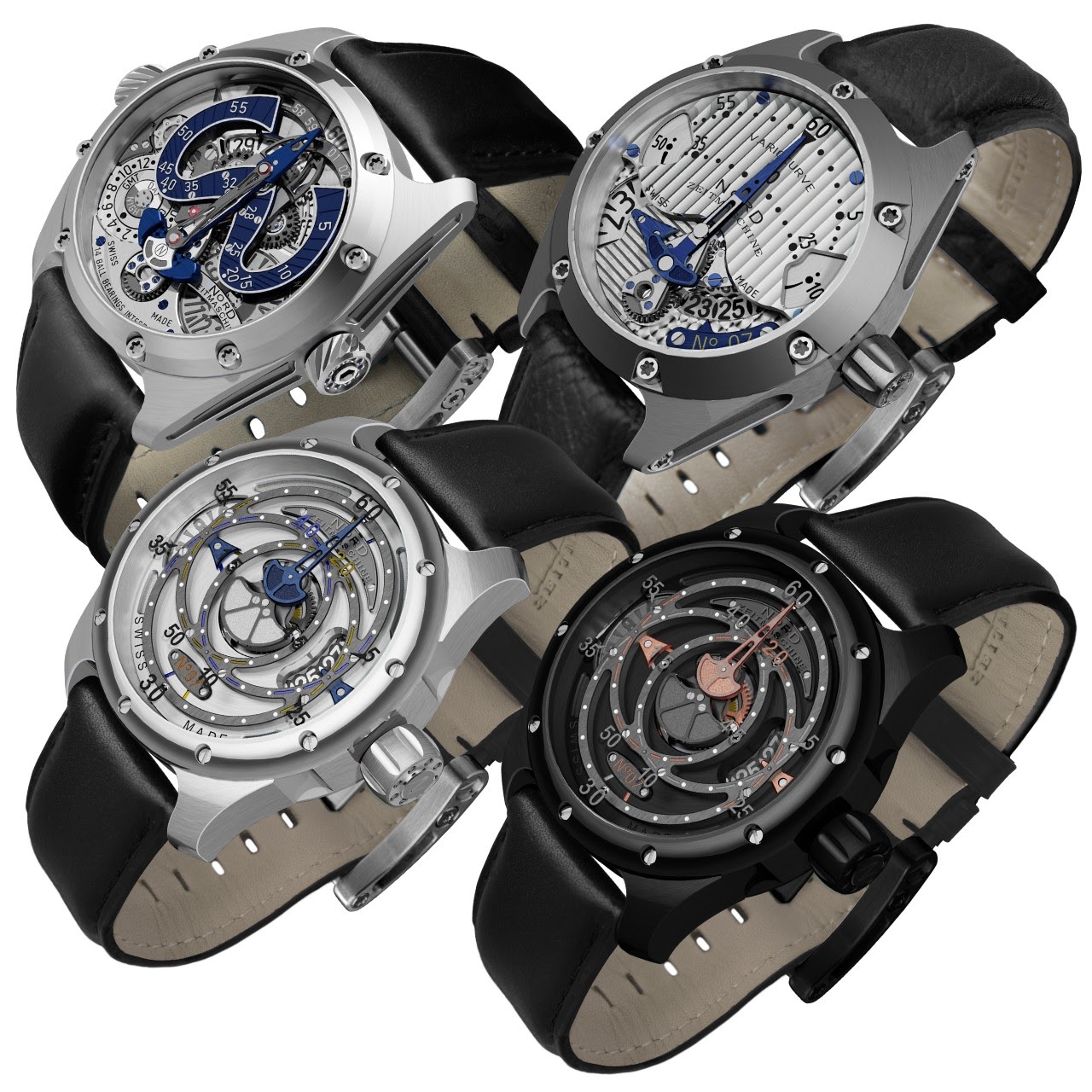
Nord Zeitmaschine by Daniel Nebel: Kinetic Art or also Watchmaking of the Highest Order?


“Kinetic Art” is mentioned occasionally when watches with an unusual time display are discussed. According to the TATE’s art-terms, “Kinetic art is art that depends on motion for its effects”. Though, I associate foremost the “machines” built by Swiss artist Jean Tinguely (1925-1991) with this form of art. The Stedelijk Museum in Amsterdam staged about a year ago an exhibition titled “The Machine Spectacle”. Tinguely’s work was already characterised in the press release: The sheer uselessness of his moving machines mocks the utility-thinking of the machine age; he loved the absurd play of his machines and was fascinated by their destruction and ephemerality. Most of the wheels fitted to the sculptures power nothing. Tinguely’s whimsical machines are erratic in their performance, and to increase the cacophony, instruments like cymbals and bucket drums were often integrated into the electric motor driven constructions.
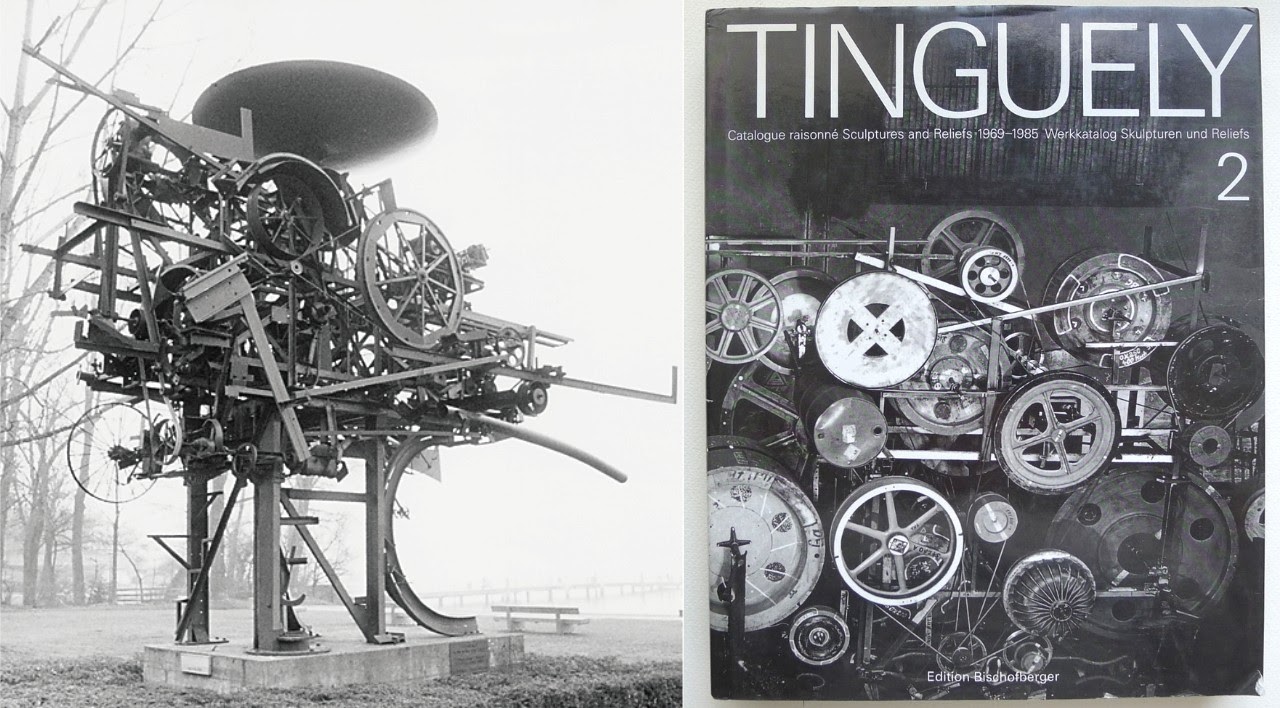
Above: (LH) Jean Tinguely, Heureka , 1963/64, Zürichhorn, Zürich (Copyright photo: Walter A. Bechtler-Stiftung; image used with permission)
Tinguely is recognised as one of the most important exponents of the kinetic art movement. But do watchmakers want to be associated with such art? The products of this art form show rather the opposite of the features you want in a watch, i.e. reliability of the movement and precision of the functions integrated.
Nevertheless, there are watchmakers who based their clocks on ideas of these kinetic art sculptures. Gordon Bradt is one of them, even taking out patents for his creations, one filed in 1982 for a “Kinetic Clock Sculpture” (US Patent 4,421,421). When reading instructions supplied with the clock based on this patent, I realised how closely it follows the idea of the self-destructing machines so adored by Tinguely: “Your Kinetico Clock Sculpture is powered by a synchronous motor and will keep good time. However, this is basically a kinetic sculpture with much more vigorous motion than found in regular clocks. Therefore, we recommend that the clock be turned off when there is an extended period of time when it will not be viewed. […] On rare occasions, a little man or one of the small gears may become jammed and the clock could stop.”
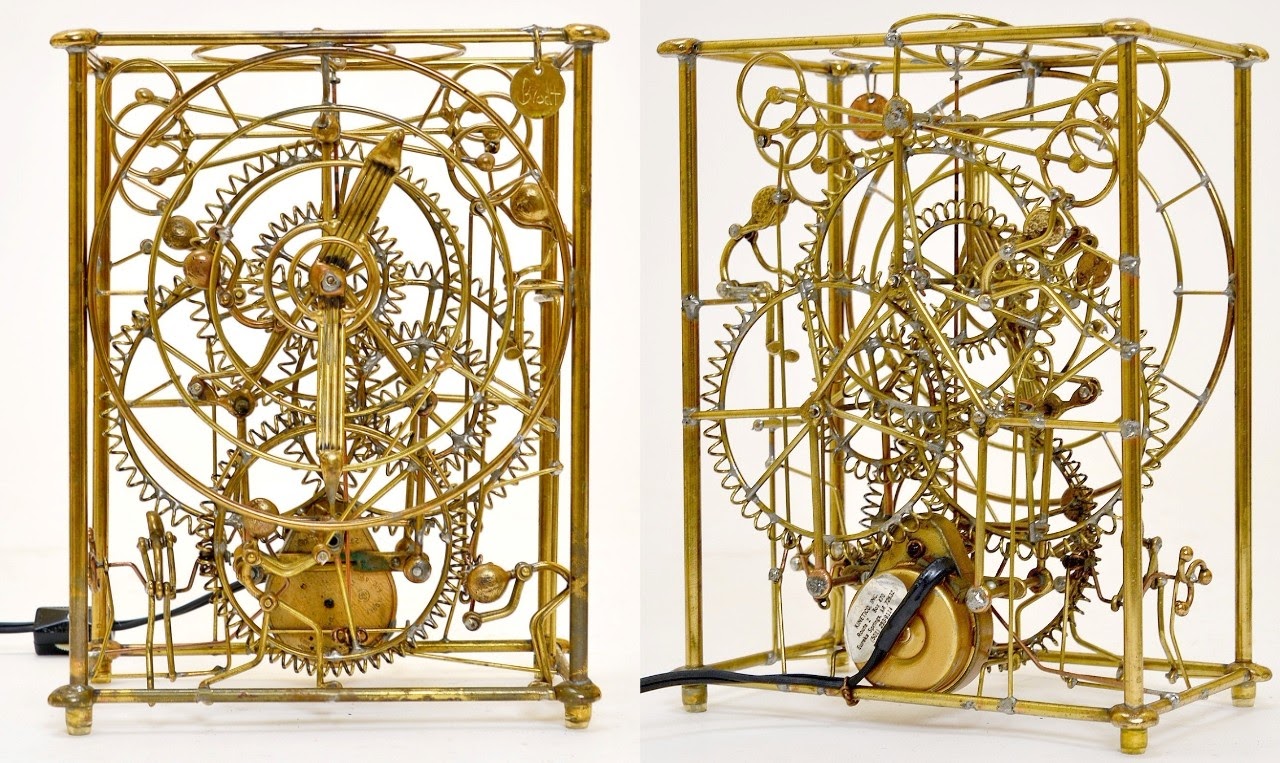
Above: Six Man Clock by Kinetico Studios, built from solid brass and copper (Photo: Colonial Arts)
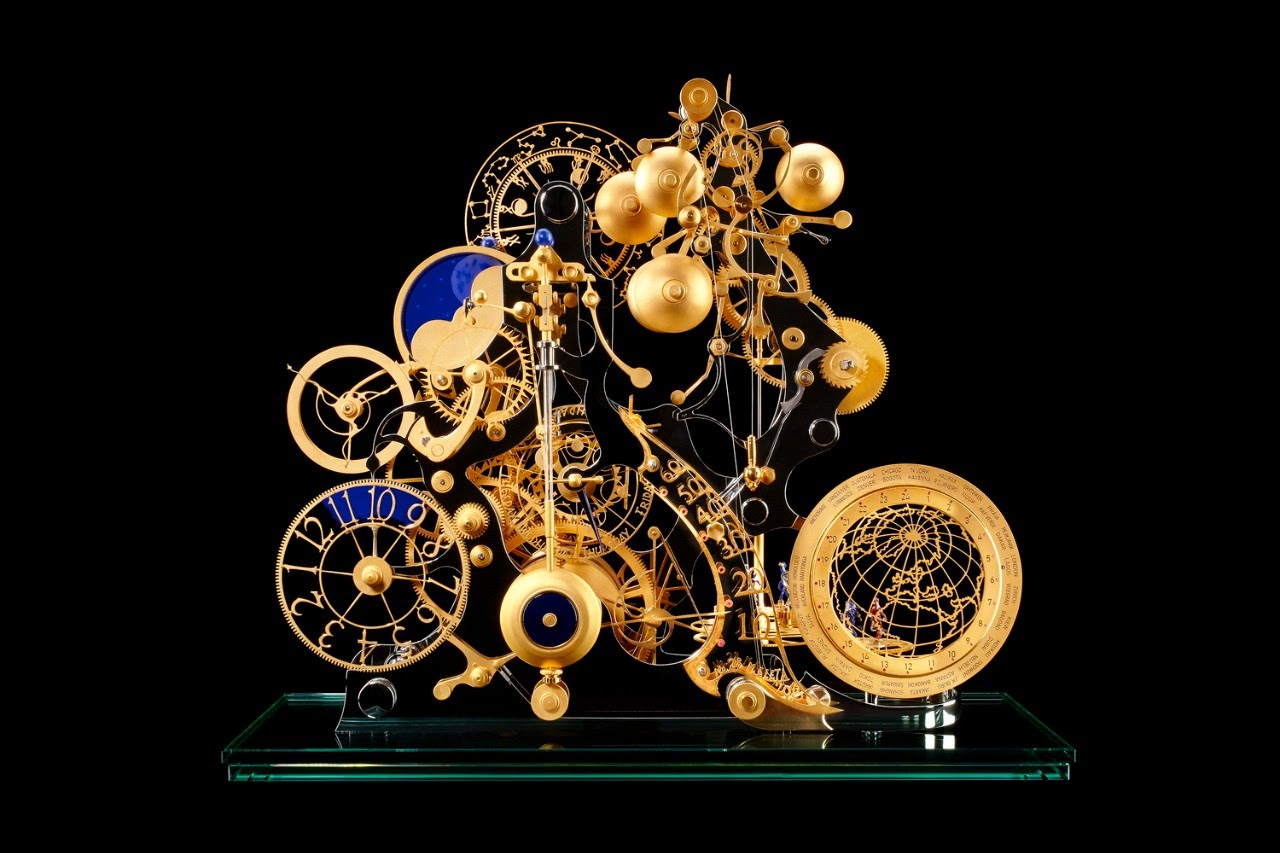
Above: Tres Caracoles by Miki Eleta, first presented at Baselworld 2014; integrated are not only seven dancer and four musician figures that perform for the duration of the music playing at the hour, but also displays for precise moon phase, weekday, world time, power reserve, constellations, month, solstice and retrograde minutes. (Photo: Miki Eleta)
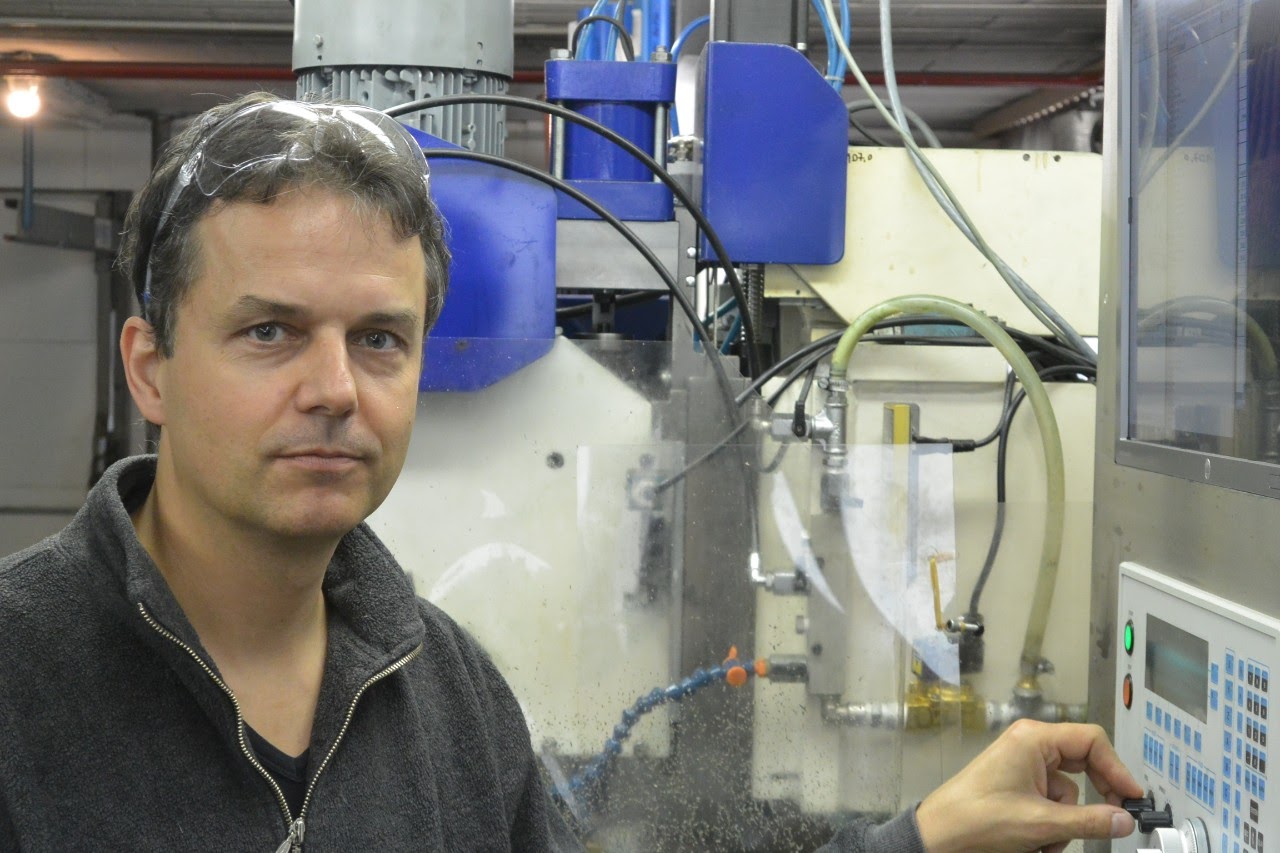
Above: Daniel Nebel (Copyright photo: Timm Delfs; image used with permission of author)
The Beginning
Daniel Nebel had nothing to do with the watch industry initially. After his apprenticeship he built metal forming machines (particularly used in the oil industry) for a Swiss specialist, and his employer sent him also to all corners of the world to set them up at the customers’ places. Being on his own in remote places like the Ural, Middle East and in Southeast Asia, he also acquired the knowledge about hydraulics and electrics/electronics self-taught. Because the experience to bring the machines to a reliable operating level was often not available locally, he had no other choice. This field experience instilled an “I-Can-Do”-attitude that was also the basis to get involved with watches.
Discussing an Omega he had been gifted with a colleague one day, Daniel Nebel got challenged with the question: “Would you be able to produce also such a case?” He told himself “of course” and soon started the first trials on a small Schaublin lathe he had at home. When happy with this first case, he also turned a dial and bought a used movement. And with this the first “Nebel” watch was born, including an interest to build more and nicer ones.
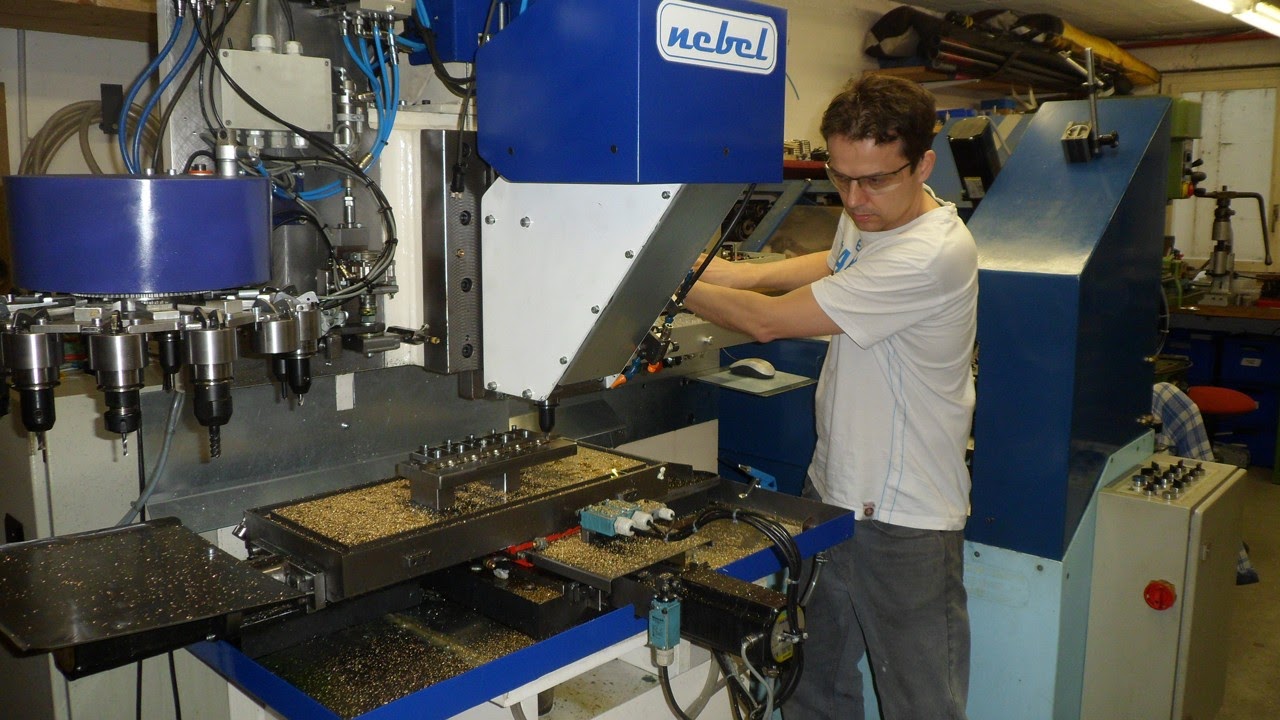
Above: Daniel Nebel operating the self-built 4-axis CNC-mill
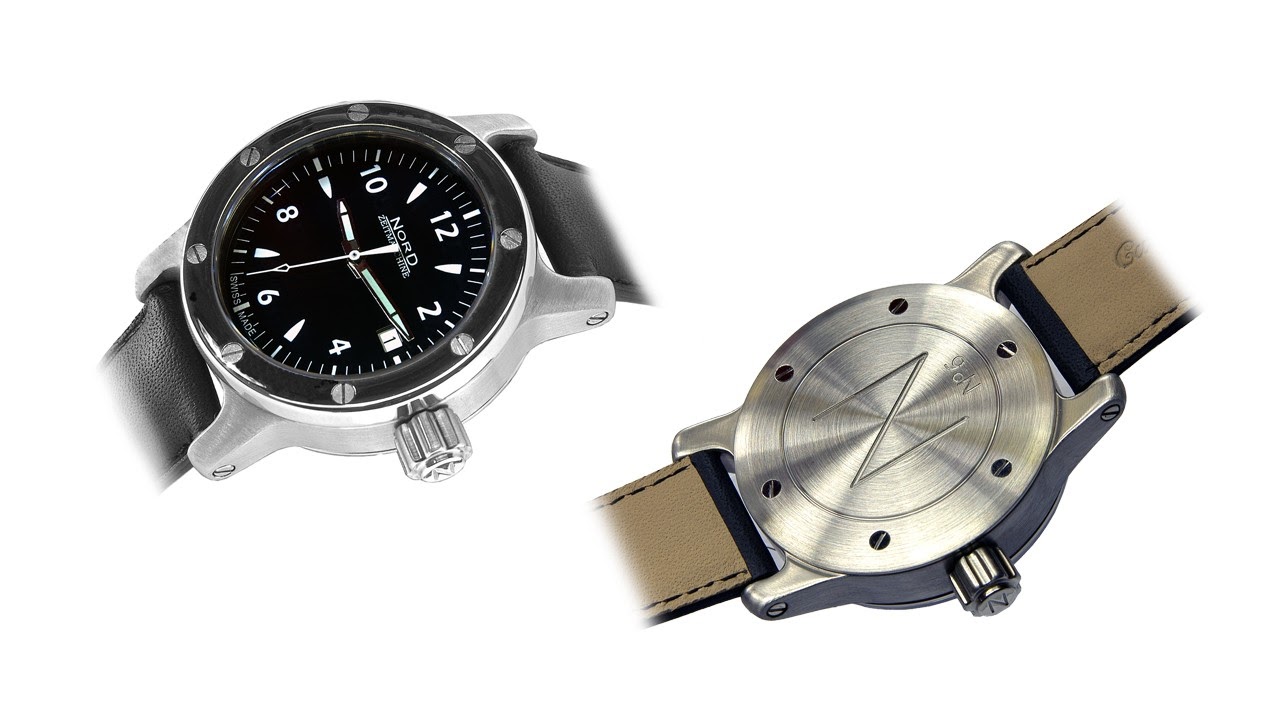
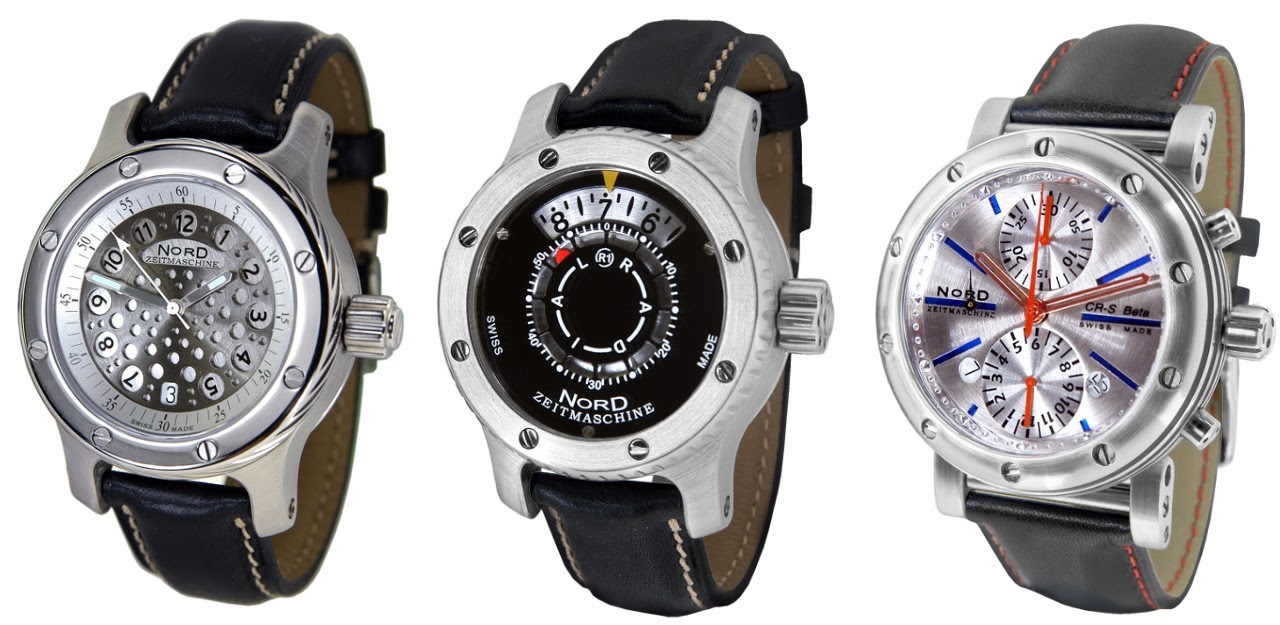
Above: The first mechanical movement collection. LH – U71, ETA 2824-2 movement, with case, dial and crown made in-house; Centre – Radial, ETA 2836 movement, now also with the modification to show hours and minutes by disks; RH – chronograph CR-S Beta, Valjoux 7750 movement, in-house case made from 70 parts, with separate lugs, each made from 11 parts. Daniel Nebel has chosen a distinctive shape of the crown and pushers from the beginning.
Variocurve
When looking for an innovative time display to bring his watches on a higher level, Daniel Nebel was drawn to off-centre hands. He wanted to get away from a displaying element (be it hands or disks) turning on a fixed pivot point, as it is the norm with watches. Yet, inventing a new kind of display was not that easy; his experiments led first to displays that were too small or aesthetically not pleasing, or did not work for technical reasons.
When two counter-rotating
gear wheels, arranged decentralized on the dial brought the pursued result, a
patent was filed. The essence of the invention is described to be a time
display mechanism changing speed as well as radii in the course of a time cycle.
The increased travel distance of the time display element is claimed to not
only fulfil aesthetic considerations, but also make reading the time easier. 
Central stage in this new time display had to be taken by the minute hand, moved by two counter-rotating cams fitted to gear wheels. The pivot point of the upper cam is sliding backwards and forwards in a slot of the hand. The construction is picking up principles used in the industry for agitators. Using precision ball bearings, friction is minimized. The construction is thus only consuming very little of the torque provided by the base movement.
The minute hand moves at a variable speed. At the turning points of the minute display trajectory (in between 15 and 20 minutes as well as 40 and 45 minutes, or at the ends of its banana like shape) the minute hand moves so slowly that readability was jeopardized, and it was impossible to have the time units properly marked on the dial. Daniel Nebel took the opportunity to introduce an additional set of moving parts, with two disks contra-rotating to the minute hand and thus also increasing legibility by “spreading out” the minute scale in the critical part of the trajectory. The two “transition” sections are thus replaced with moving minute disks fitted directly onto gear wheels that rotate the correct corresponding minute marking under the slowed hand. This is kinetic art as an engineer sees it.
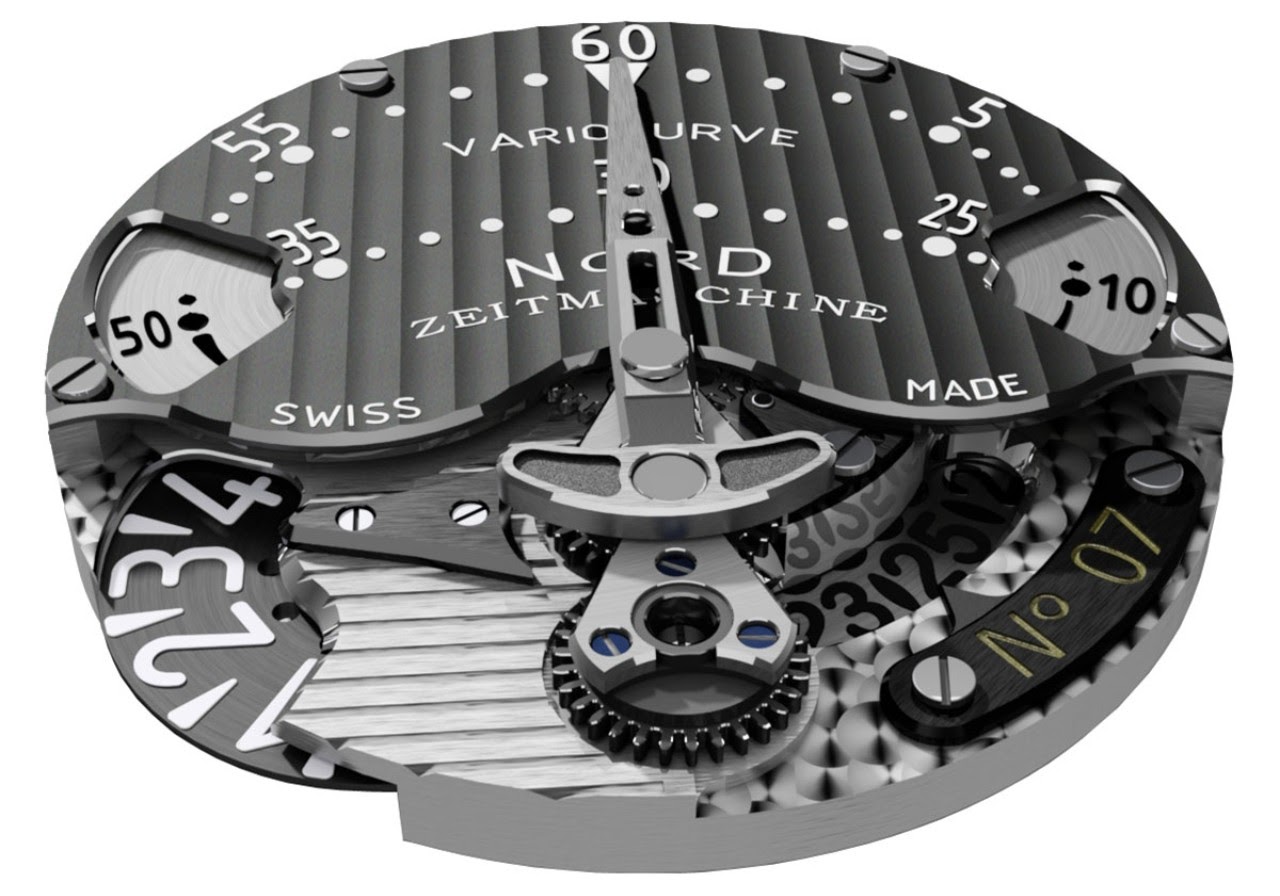
Daniel Nebel created also the graphic design of the watch himself. With this first model he introduced a trait continued with all models: If a properly machined marker can be fitted, there is no reason to employ just a blob of paint to point to the relevant hour respectively date on the disks! I wondered also about the idea behind the typeface used that looked special to me. But I was told all was found in the standard Word typography. You only have to scroll on the typeface list until something is found what looks appropriate for labelling a “machine”.
A kind of “Geneva striping” is applied to the Variocurve dial, jokingly called “Büsseracher Streifen”, referring to the place of the workshop. The striping pattern is narrower than with stripes labelled “Geneva”. This decoration is also done by Daniel Nebel personally in his workshop, with a tool constructed to get the required precision.
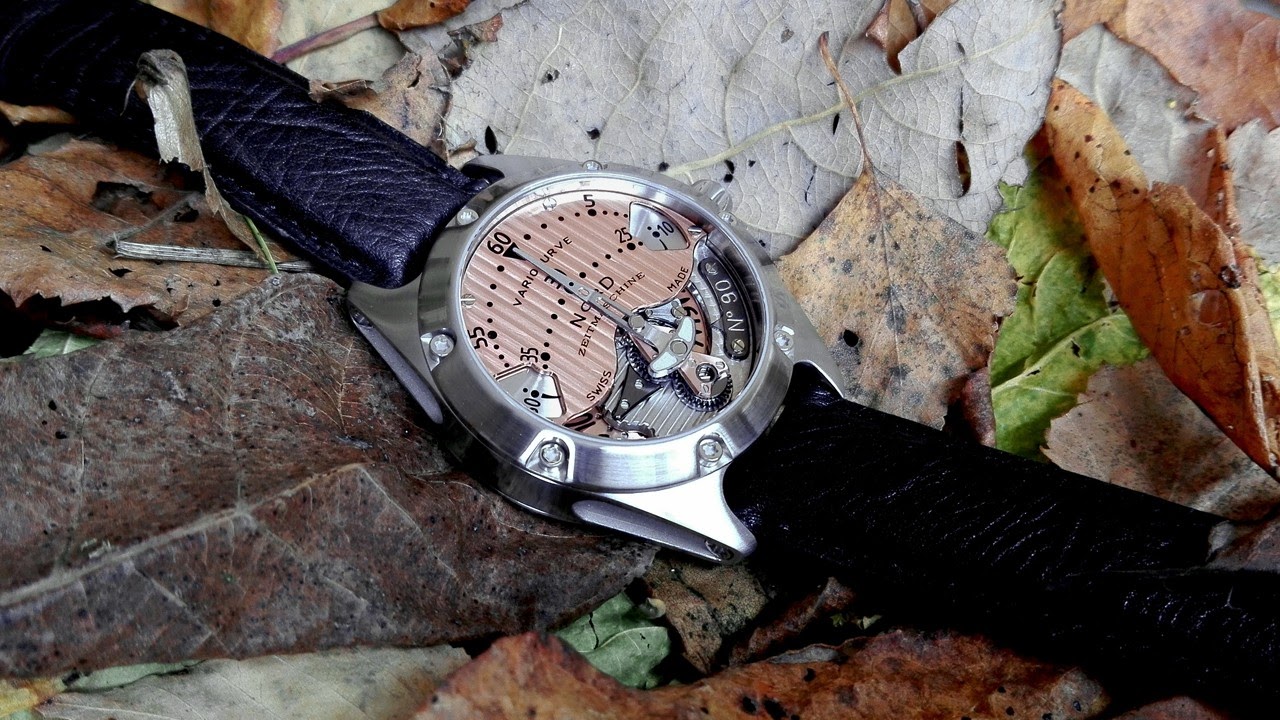
In my view the time - the hours displayed on a disk at the 8 o’clock position (on a standard dial display position) - and the date at about 5 o’clock can be read at a glance on the Variocurve model.
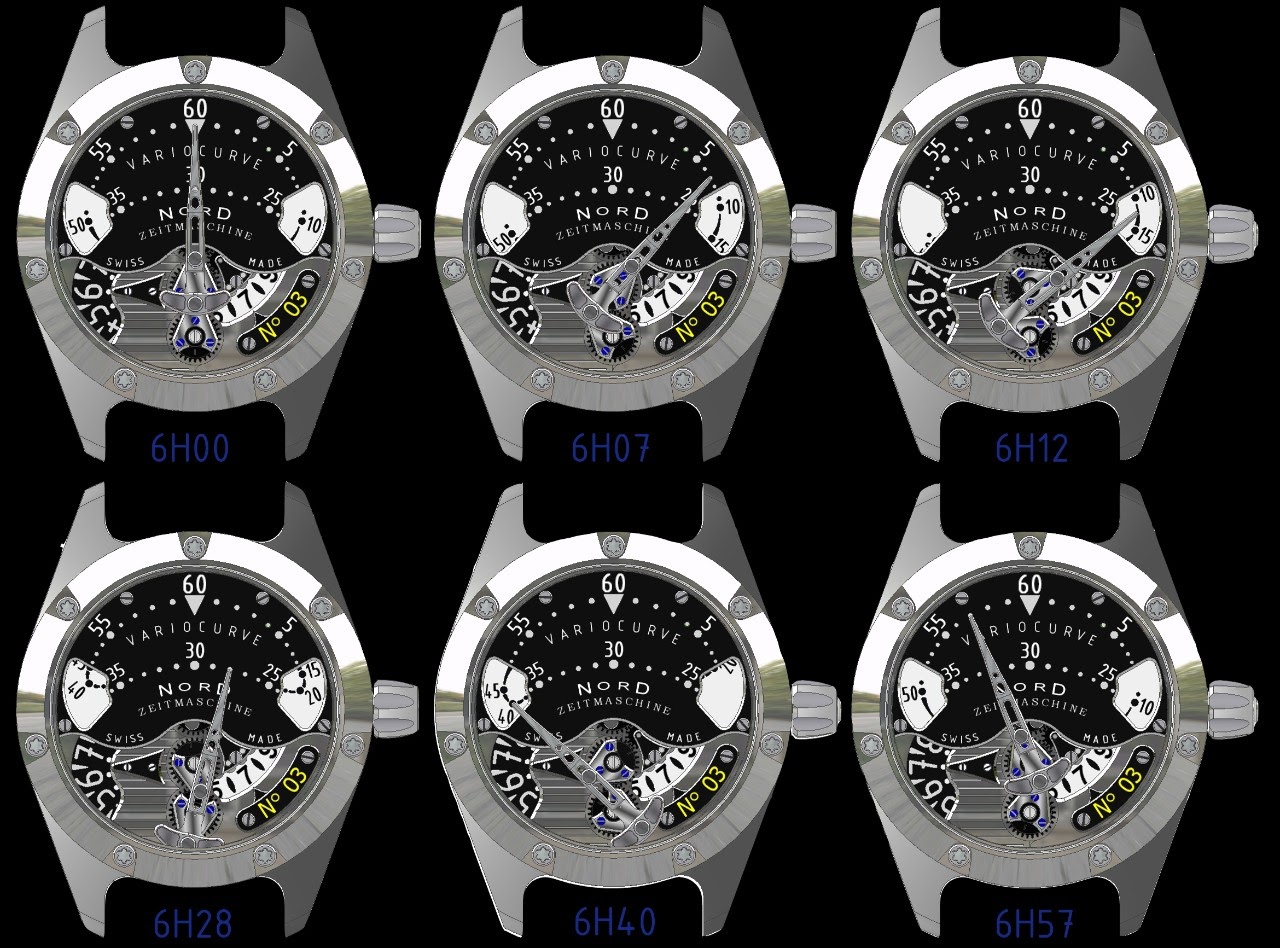
The distinctive shape of the case introduced with the Variocurve was kept on the latest model, the Freesdial . Together with the convex shapes of the bezel and case-back, the considerable height required for the module and minute hand mechanism is cleverly concealed. The flowing shape of the top surfaces of the middle part of the case is combined with a curved side profile integrating the lugs in one continuous line. I have seen the watches described to have a touch of rawness, but for me it is amazing how Daniel Nebel mastered as design amateur all the issues to create very pleasing, coherent looking and still wearable watches, despite all the space consuming mechanical creations that have to be fitted into them.
The elaborate crowns built in-house since the beginning are also not to be found elsewhere. When there is one easily visible proof that nothing is too much work when he personally enjoys a detail, then it can be found in these milled crowns (which are also easy to use because there is something to grab).
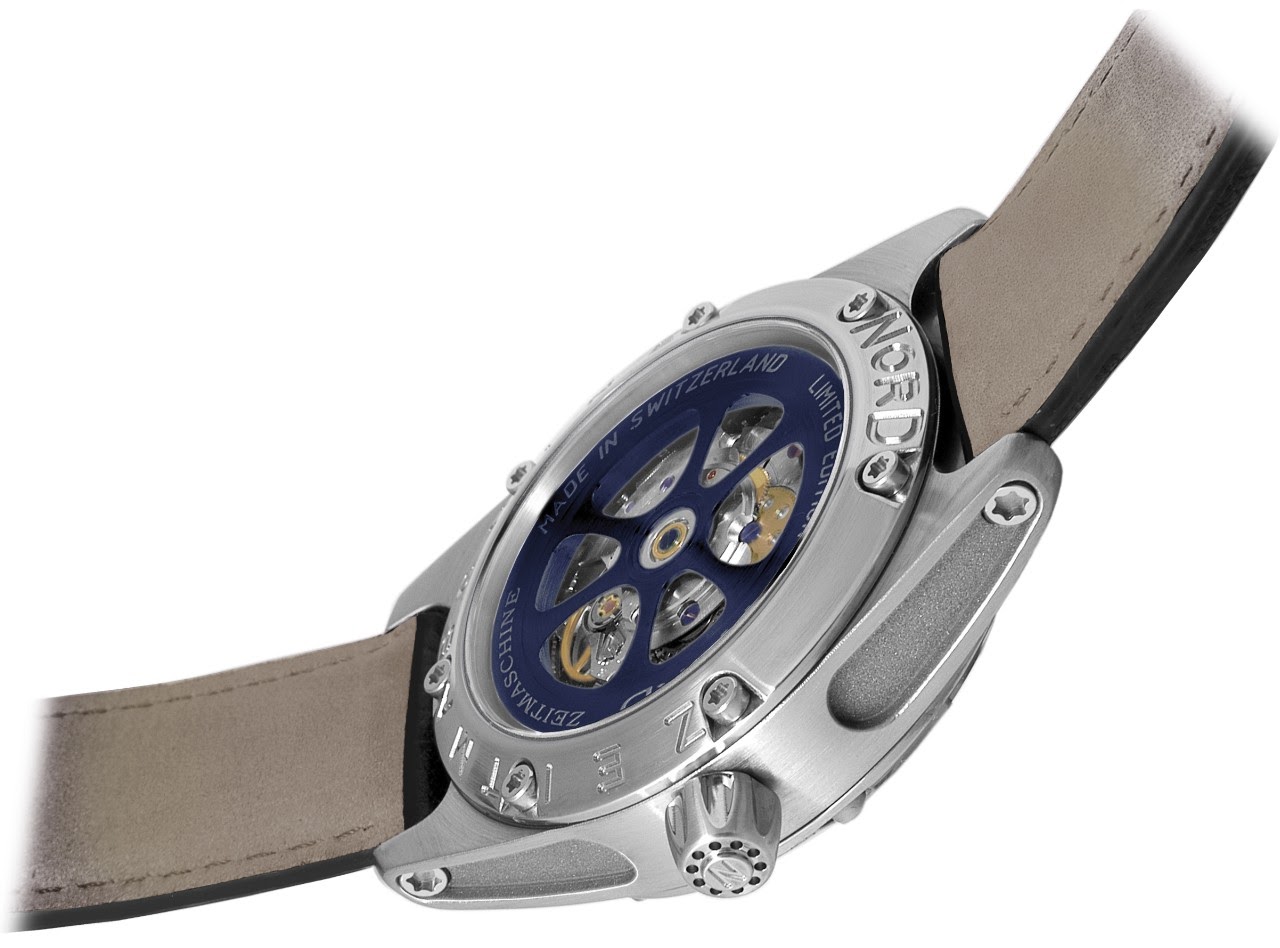
Above: Daniel Nebel produces an in-house rotor to replace the one coming with the ETA base movement. The full frame rotor works because the necessary imbalance is created by milling away sections of material on the backside of the rotor. There are not only aesthetic reasons for replacing the rotor, but also to not let the ETA base movement become too prominent, even though it is judged as ideal for the purpose due to the high torque it provides.
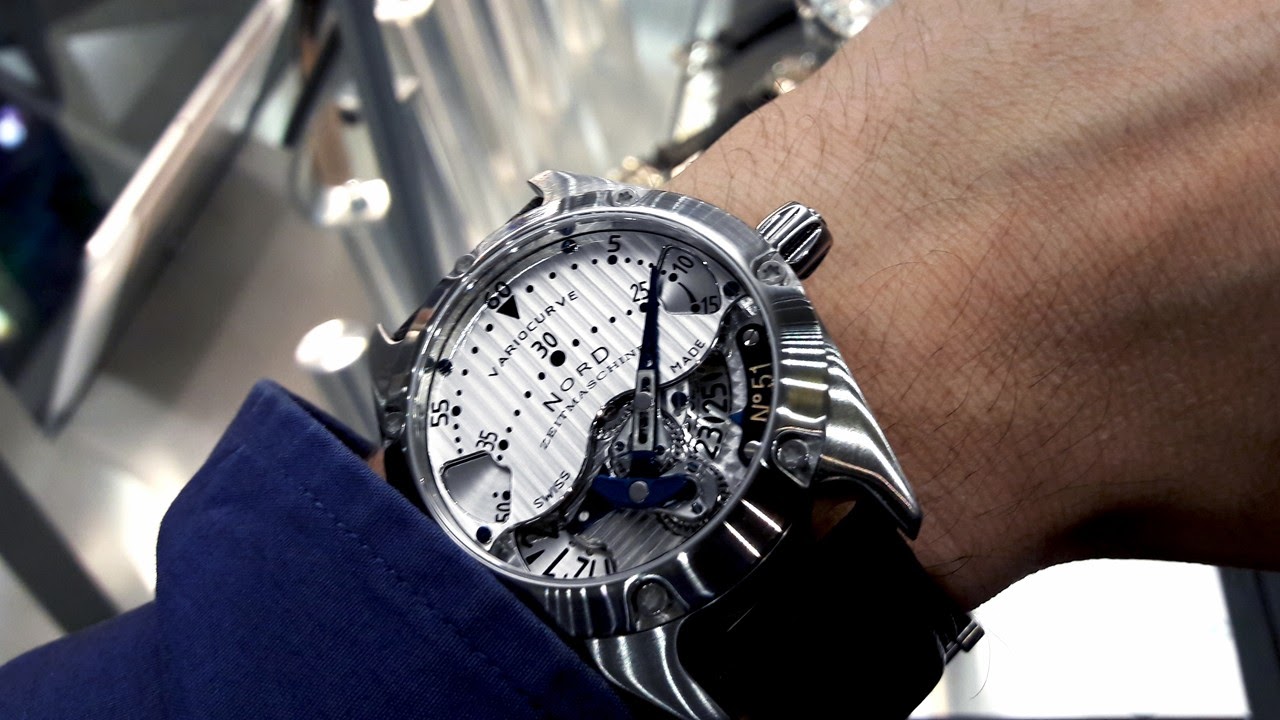
The play of minute hand and sub-dials is best explained by a movie:
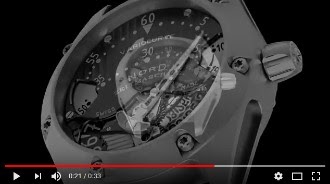
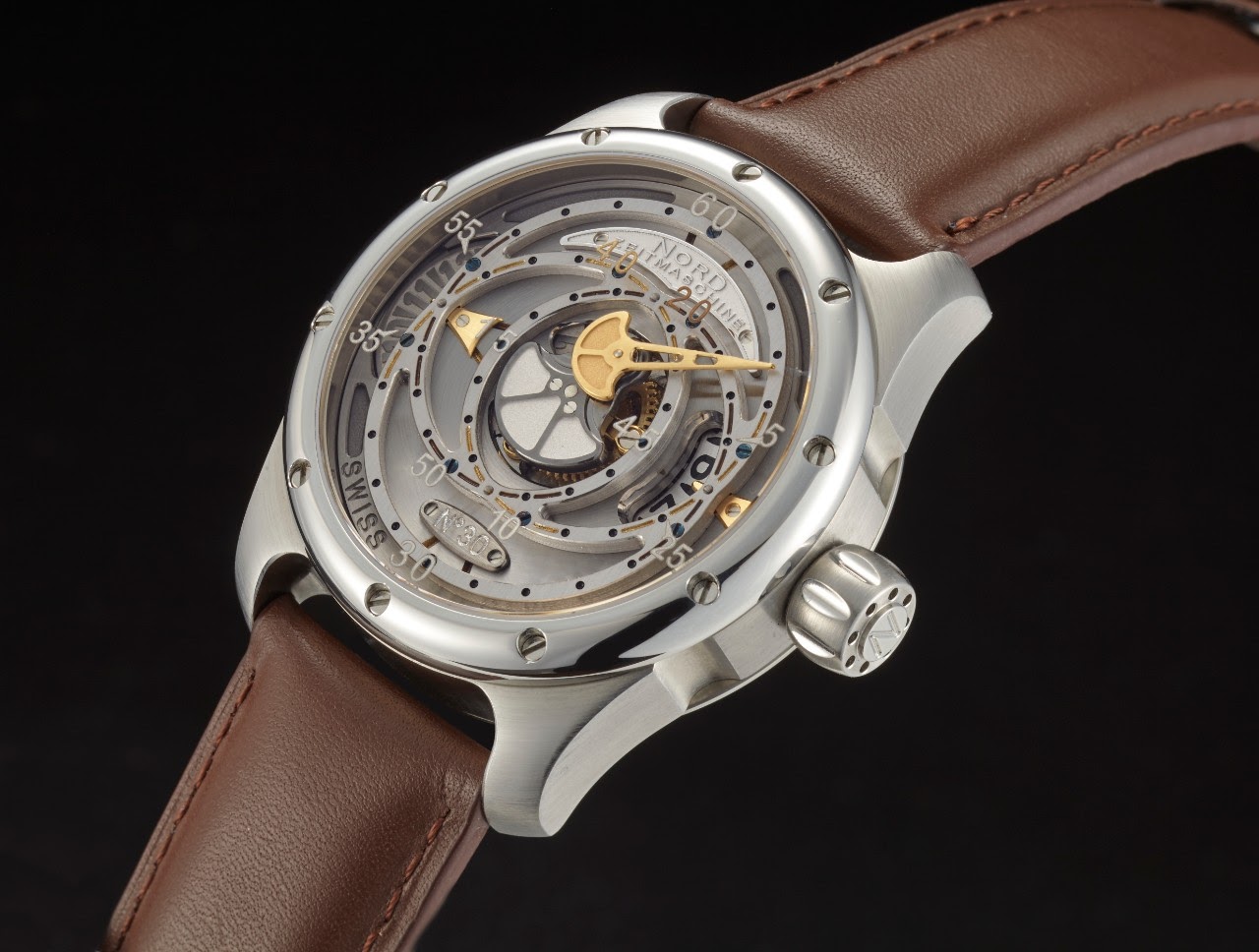
With the Quickindicator model first shown at Baselworld 2013, Daniel Nebel kept the basic layout of the Variocurve (with the hours and the date displayed on peripheral disks), but had the minute hand up the performance of its dance on the dial. The owner can see here the minute hand move by just glancing at the watch because its moving speed was increased to 205 mm/hour (standard with a conventional time display would be about 88 mm/hour).
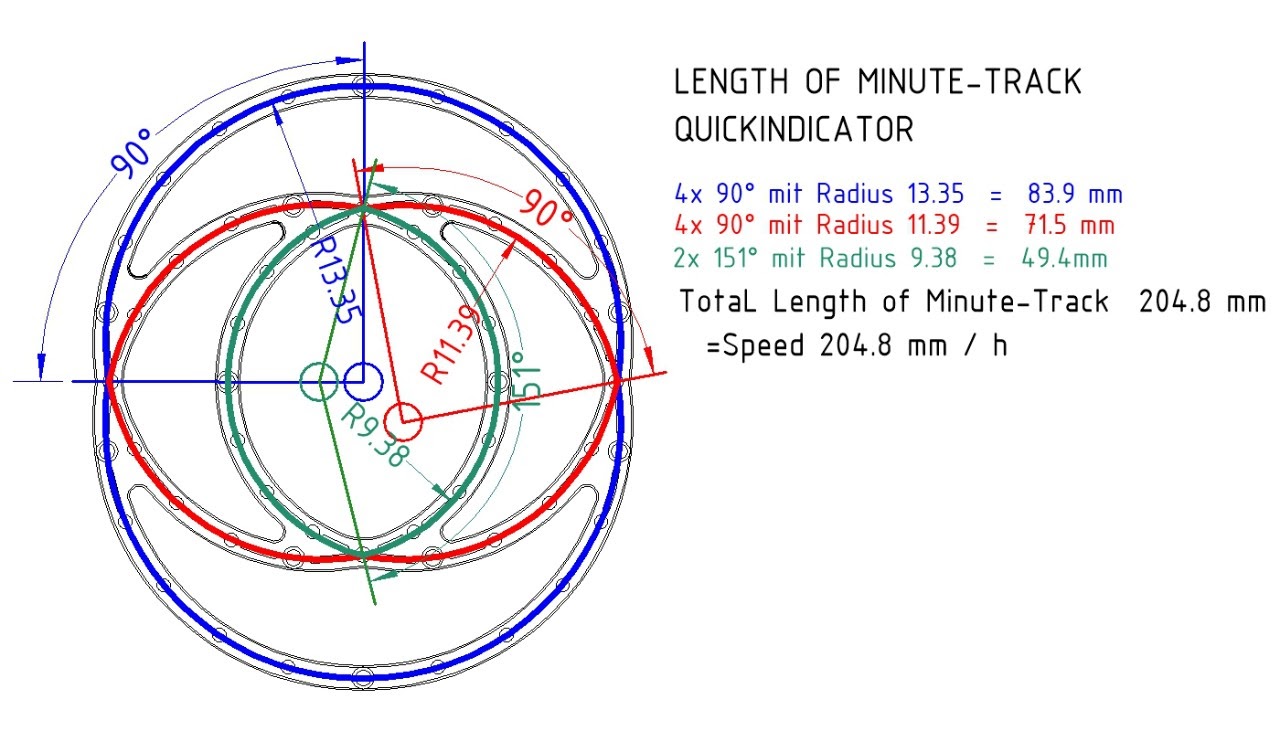
On this model, the minute hand turns three times around its eccentric pivot point within an hour, its tip never following the same track on its hourly tour. The three milled ovoid minute-tracks become as a labyrinth a prominent decoration element with a function at the same time.
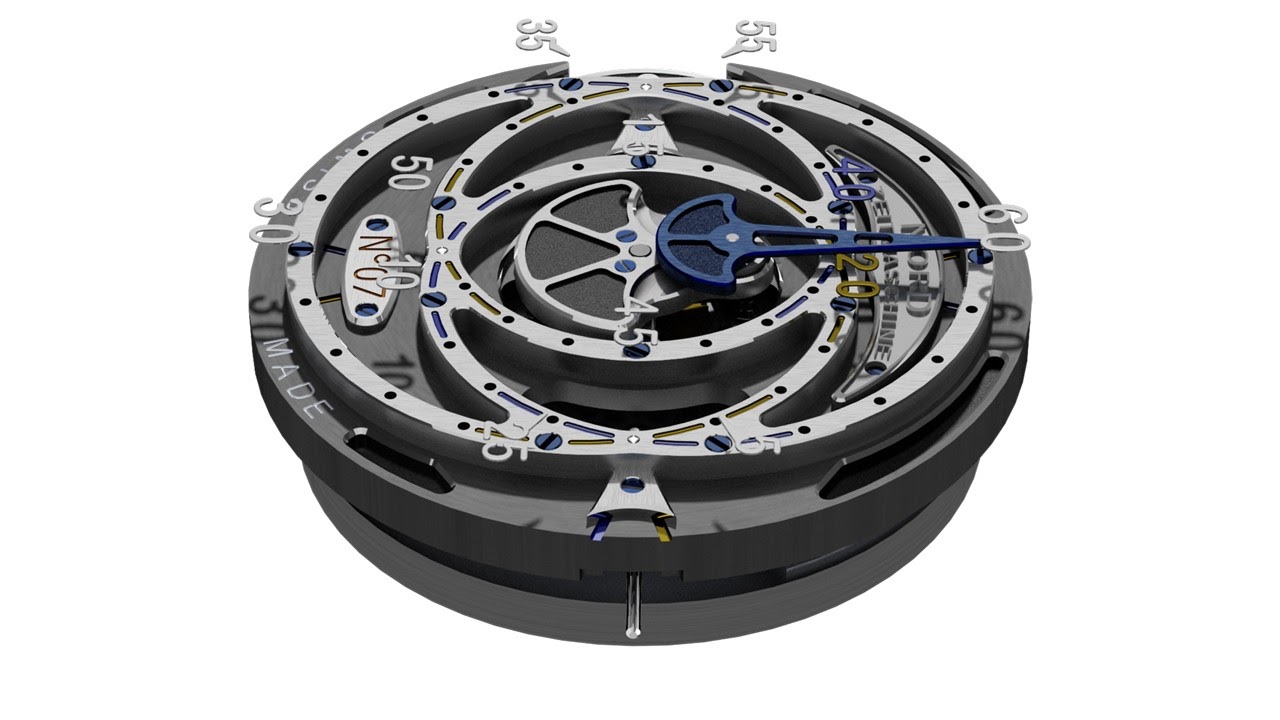
The tip of the elaborate minute hand has to follow three overlapping minute tracks to display 60 minutes. The minute hand has two pivot points for this performance. It is part of a group of 15 mechanical elements, consisting of hand platform, gear wheels, ball bearings, shaft, coupling and screws. The assembly is about 37 times heavier at 0.74 grams compared to the typical hands used in watches. The challenge was thus to have such a construction precisely balanced, with two pivoting points to be considered: In addition to the minute hand itself, the complete group of parts has also to be exactly balanced on its drive connection to the base movement, whatever the position of the minute hand and/or the hand assembly is on its tours around the dial. To find a technical solution working in all positions must have been real fun; I got already sick in school when I was asked to solve an equation with three unknowns in mathematics. Though, Daniel Nebel is constantly looking for challenges, which include here not only calculating and constructing, but also producing himself each and every part of these complex and intricate mechanical jewels.

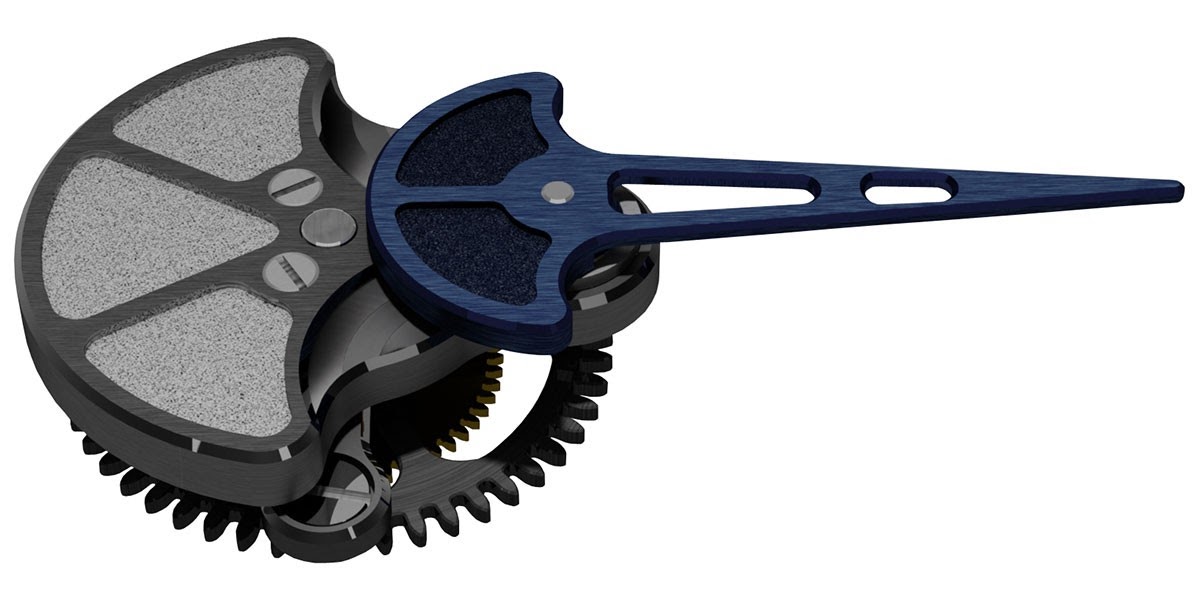
The 15 individually finished parts of the minute hand assembly are not only a visual treat, but the unit is also perfectly balanced to not unduly burden the base movement and ensure the precision expected of a quality watch.
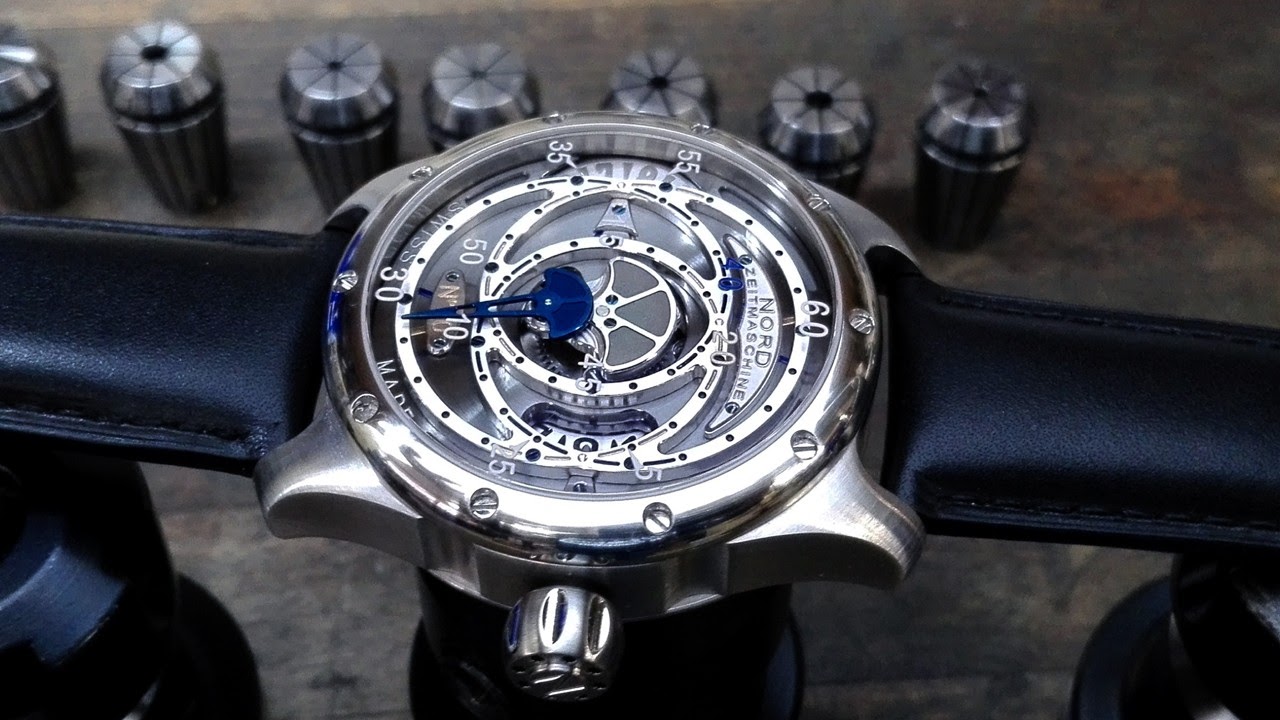
Compared to the Variocurve (or Freesdial ) it is much more difficult to read the minutes off this watch when not yet familiarized with the display. It is a bit like to distinguish identical twins: I just needed a hint to look for a relevant detail to henceforth read the time at first glance. Here we have the two differently coloured markers beneath the series number plate. The tip of the minute hand is poking towards the marker bearing the same colour as the track the hand will take beyond the intersection. Well, you could wait 20 seconds to find out if you cannot figure out the tracking the minute hand takes. Whatever irrelevant detail, Daniel Nebel does not want to leave anything undefined! His measures feel a bit elaborate. Though, these details are part of the fun you have with this watch as well as the assurance that its maker has considered every possible problem in designing and constructing it.
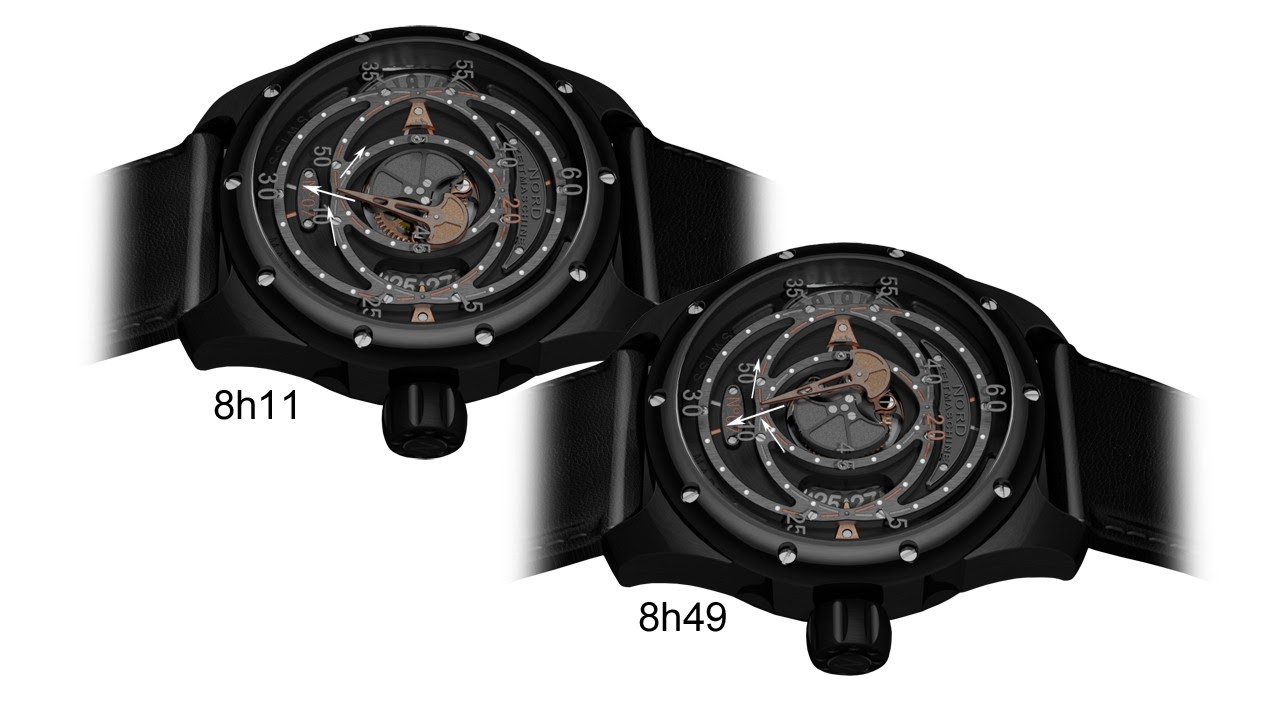
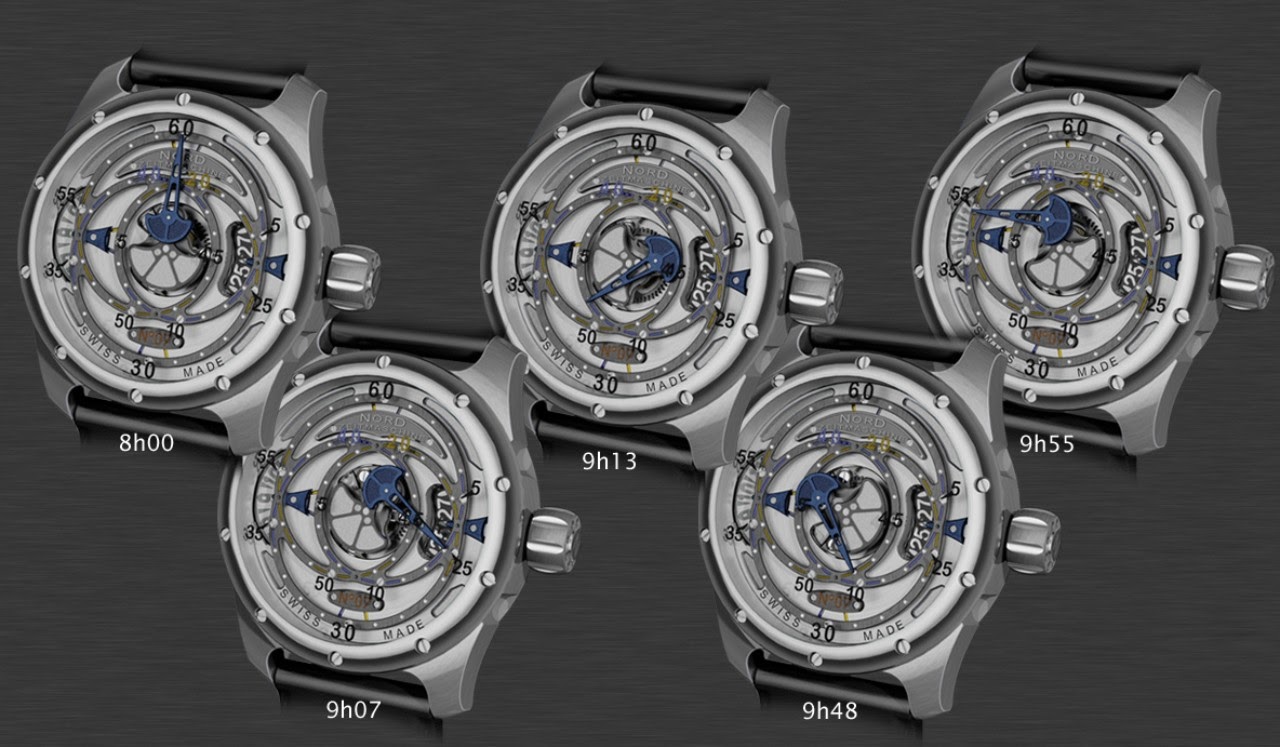
A first training unit can be found here:
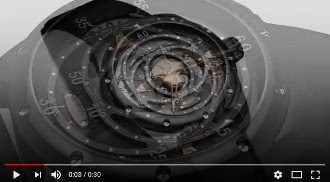
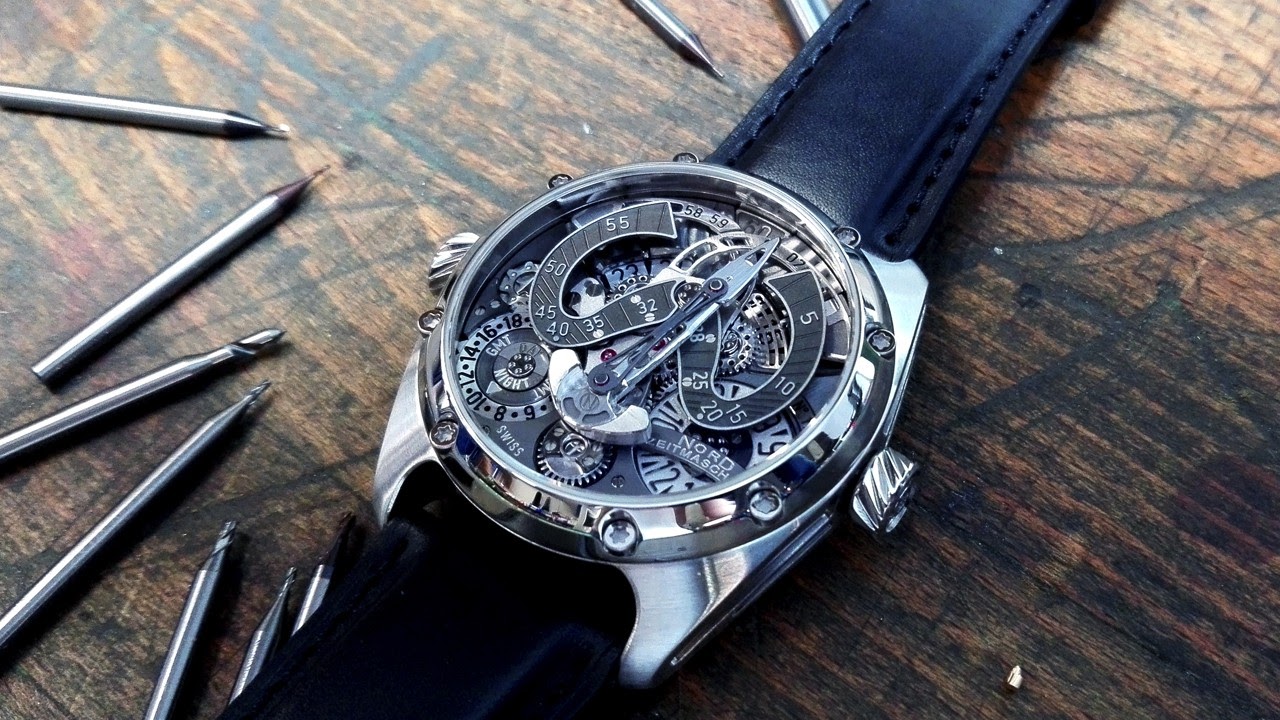
With the Freesdial model introduced at Baselworld in 2016, Daniel Nebel revisited his original ideas realized then with the Variocurve model. With a GMT display added and the dial also being integrated in the assembly of moving parts, everything got more sophisticated. The minute hand has now given up the solo waltz dance, and found with the dial a dancing partner that requires less wild moves. The necessary coordination challenged even Daniel Nebel as choreographer.
Using almost exclusively precision ceramic ball bearings in the module construction instead of rubies does not only support longevity, but reduces in addition friction because no lubrication (oil or grease) is necessary. Ball bearings are also a technical requirement to facilitate together with the levers the large movements required by the time displaying parts.
Furthermore, using ball bearings makes bridges redundant (e.g., required for the hour and date displays if rubies would have been used). With the Varicourve and Freesdial the minute hand constructions can only work with ball bearings (gear wheels only fixed from the bottom side) otherwise a pivot would block the dance floor.
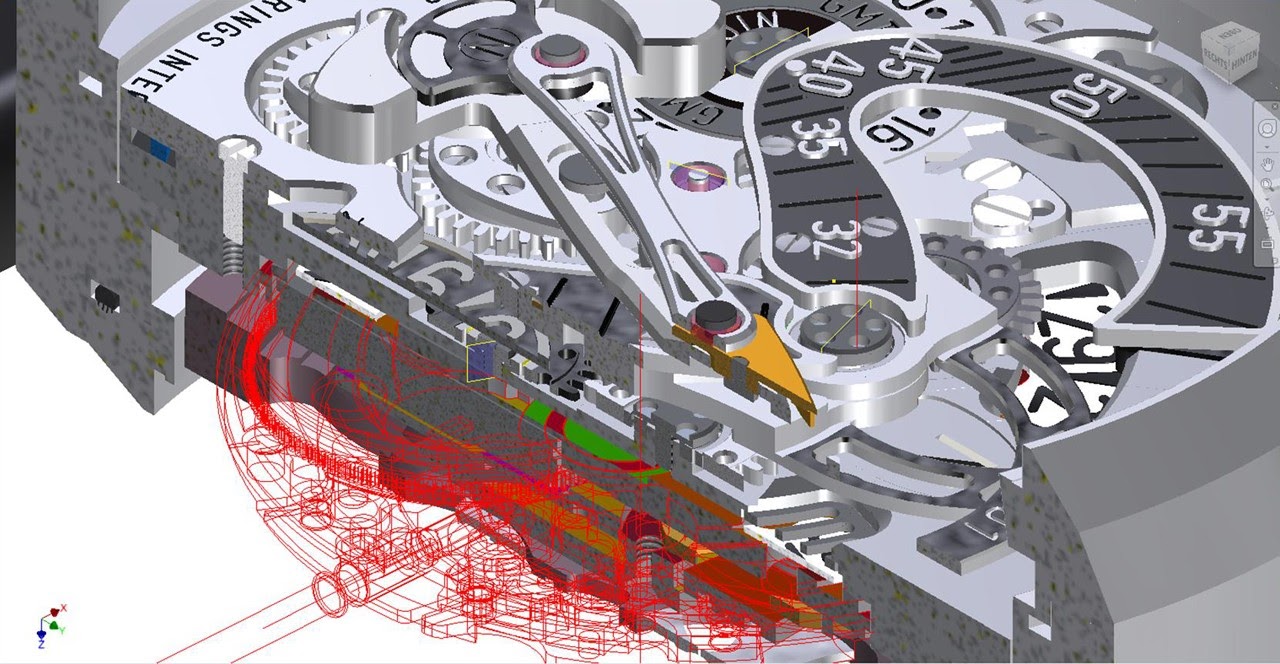
Above: The cutaway view shows how well the base ETA 2824 is integrated as engine into the watch construction. The module becomes the dominant part, and again the construction with the heavy and off-centre moving parts had to include balancing elements to ensure a reliable function. To avoid any loads on the cannon pinion, the module is built like a separate movement.
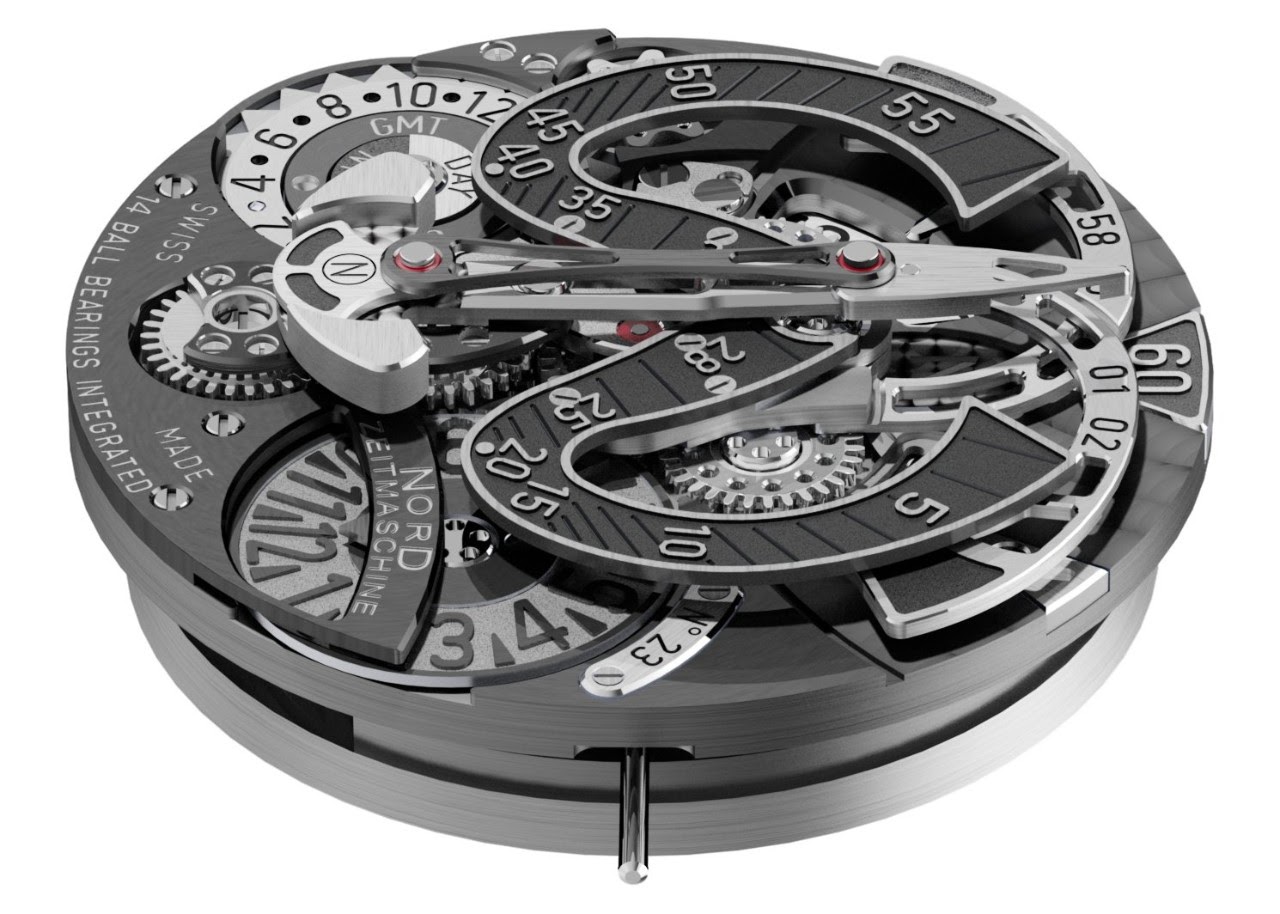
Above: Creating all the functions the module has to perform, several height layers are necessary. Eccentric cams on top of the gear wheels provide for free moving minute hand and dial sections. All these moving parts have to be coordinated to show the time precisely. Daniel Nebel even claims that the resolution of the time display is improved by dials and minute hand moving in opposite directions, thus making it easier to read the minutes compared to a standard display. Whatever, the unusual movement of these parts certainly offers a constant spectacle. It is almost impossible to describe it in words, so better have a look at the film below.
Below: The cut-away illustration shows a movement respectively module construction with completely different aesthetics compared to conventional watchmaking. The impression of a machine with intricate mechanics crammed into a tight space is clearly there, yet you still get the absolute precision of a top watch. In addition to 30 rubies, 14 precision ceramic ball bearings help to get this result from the “jungle” of parts. Everything is so over-engineered that Daniel Nebel is sure it will all still properly function in 100 years.
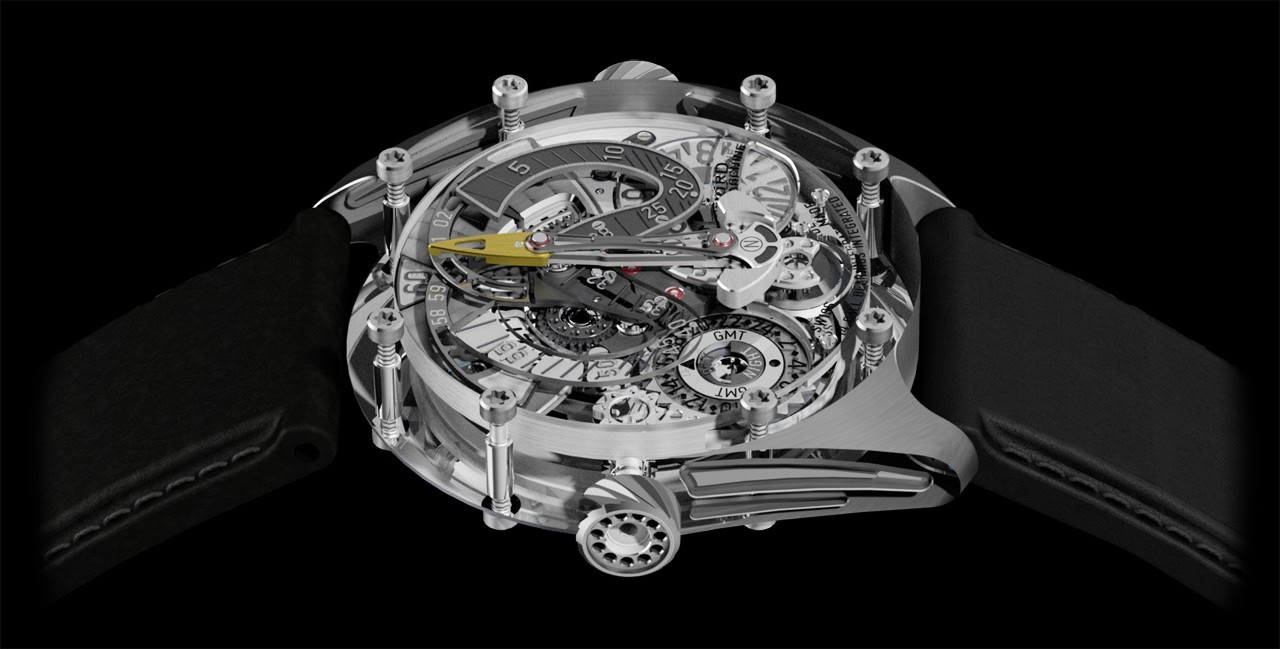

Above: LH – Hours are displayed by disk… RH - …. and so is the date. To please his desire for symmetry, Daniel Nebel made two openingings for the date disk, covering one partially up to avoid confusion. Well, considering the quantity of all the parts requried, it does not matter to have to mill an additional one for the covering mesh.
Below: The GMT display can be independently set with the LH crown, manipulating the 24 hour ring. The dot fitted on the inner ring vis-à-vis the time marker helps to read the time when the 24 hour disk is momentarily and partially covered by the dial section. You can read the figure near the dot and add 12 hours… Nothing shall be left to guessing!

Below: The reading help offered in the literature is in my opinion not necessary for the Freesdial model. The displays on the disks as well as on the minute dials can be easily read. On the other hand, the illustration shows nicely some typical dance positions of dials and minute hand.
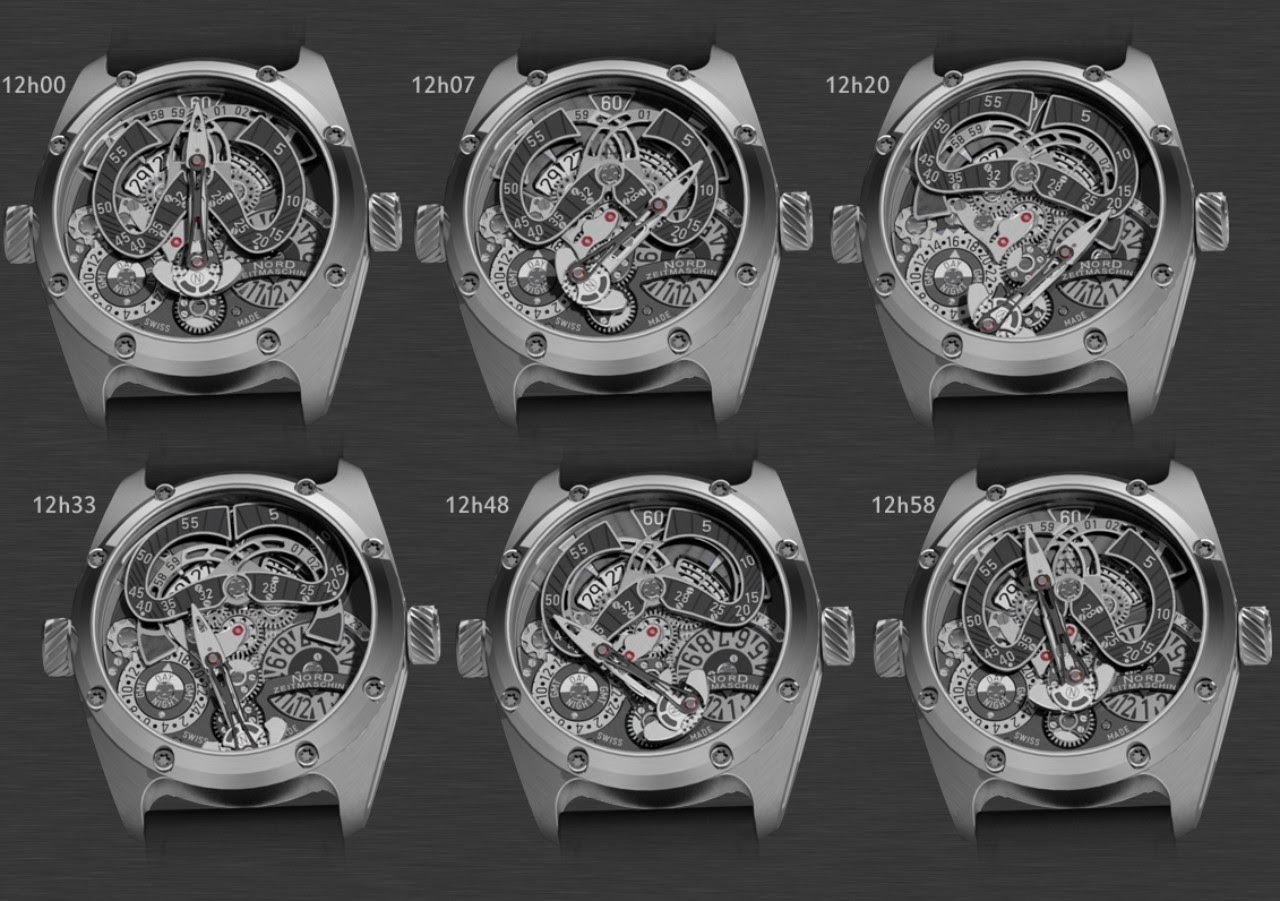
Below: The minute hand is driven by two contra-rotating gear wheels. An eccentric cam is fitted on top of both gear wheels. This mechanical arrangement leads to a constantly changing pivoting point of the minute hand; it changes also continuously its speed. For a further complication, an additional eccentric cam is fitted on the hand assembly which extends and extract the tip of the minute hand with a connecting rod. The minute hand as well as the “turntable” base assembly have to be balanced with counterweights, to keep the respective weights exactly on the pivoting points, whatever the position of the parts in their cycle. What work has to go into such a mechanical device when you produce every single part in-house, is just incredible.
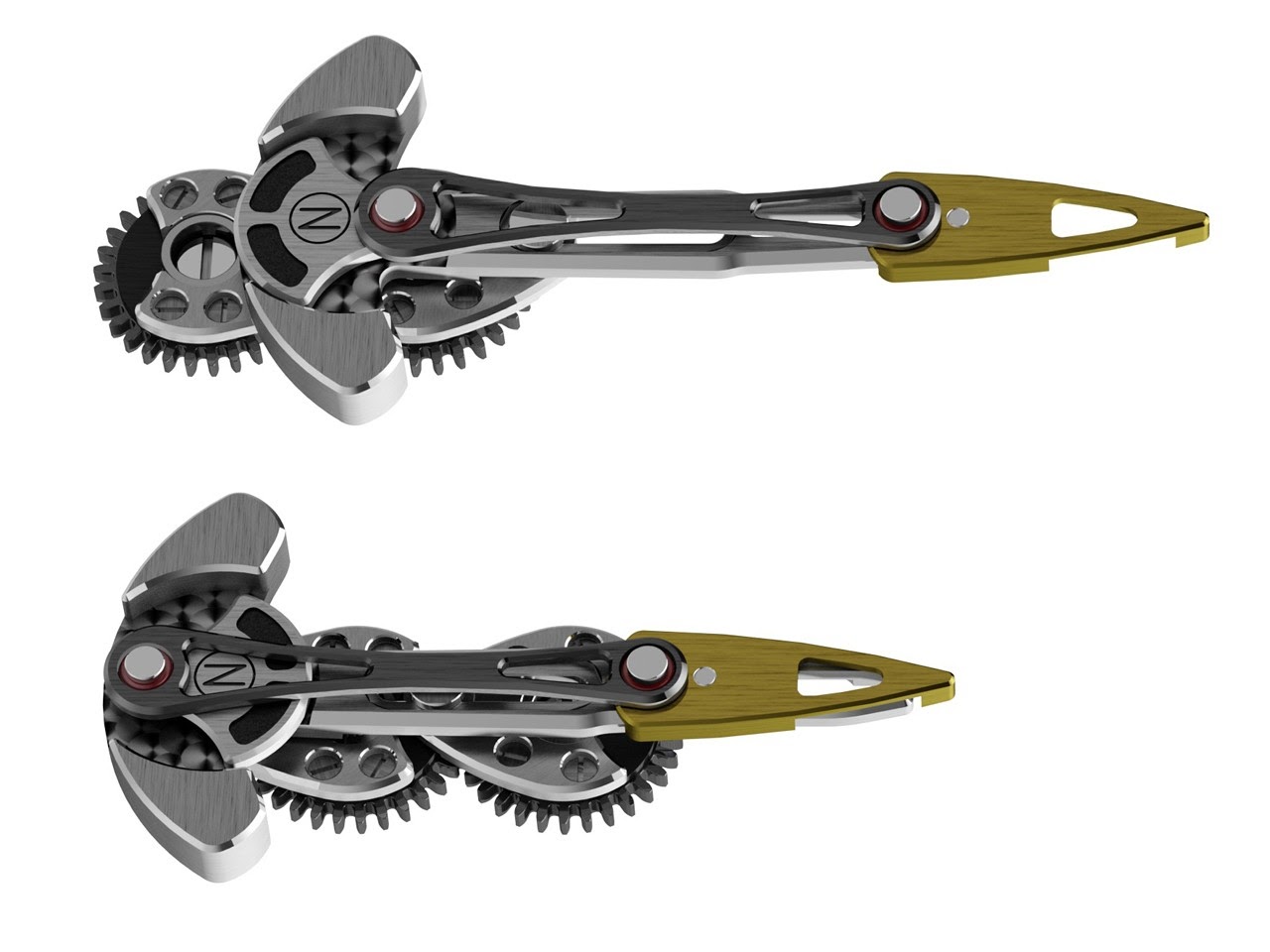
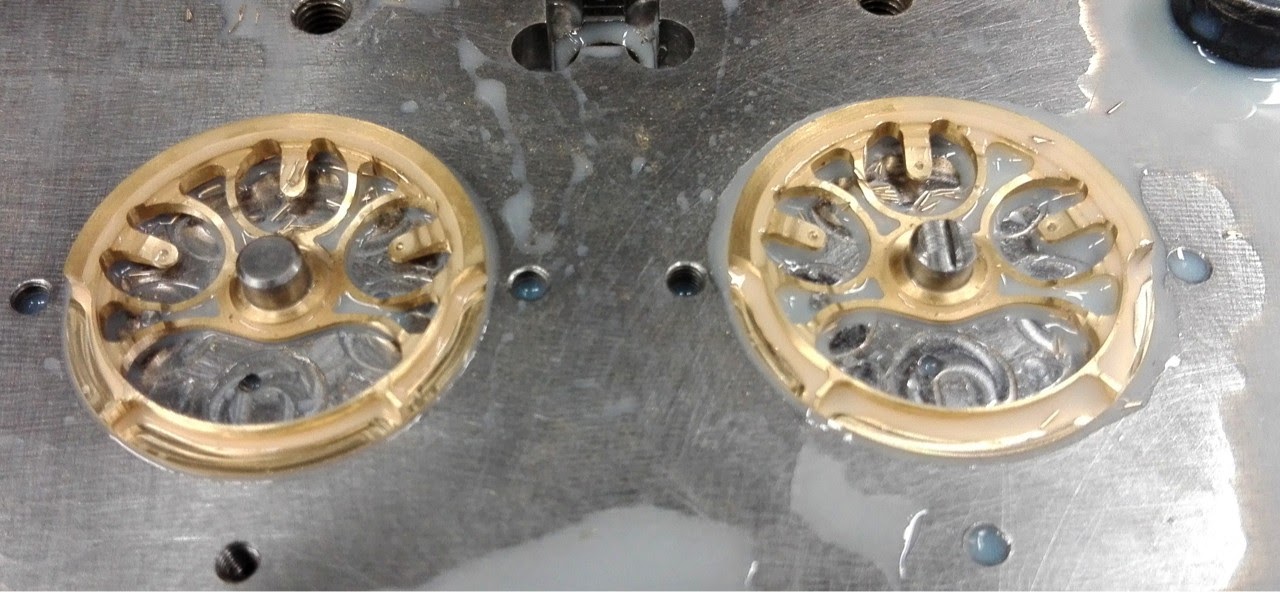
Above: The full frame rotors are also milled from solid blocks of brass. To make them functional, material is partially removed on the backside. With the Freesdial model the construction is more elaborate because three separate and freely turning disks are fitted inside the rotor. Just for the sake of the spectacle.
Below: The three free spinning disks inside the rotor are also running on ball bearings. To make them turn when the watch gets moved, the same principle as for the rotor is used, i.e. the material on the backside is partially relieved to create an imbalance. These indicator disks have no other function than to be an additional element to play with. The watch owner is invited to some gambling, trying to line up three times the ‘7’ to point towards the centre…
To appreciate such additional “complications” requires an open-minded enthusiast. A watch with the features of the Freesdial attracts, of course, in the comments’ section of, e.g., “The World’s Most Popular Source for Watch Reviews…” assessments like: “Amusing the first two or three times one watches a speeded-up video of it in action. After that it just seems like complication for its own sake - with no advantage other than the novelty factor.” Hey, yes, so it has to be, we are talking kinetic art and are not looking at a strict tool watch!

Amazingly, non-watch-enthusiasts are attracted to these watches, as I found out when wearing mine in daily life. The curiosity is friendly and genuine. If a discussion arises, you can show the exquisite mechanics and have not to explain just some gaudy decoration that cries “Look-at-me”. So you have an acceptable provocation and “ice breaker” for an idle conversation.
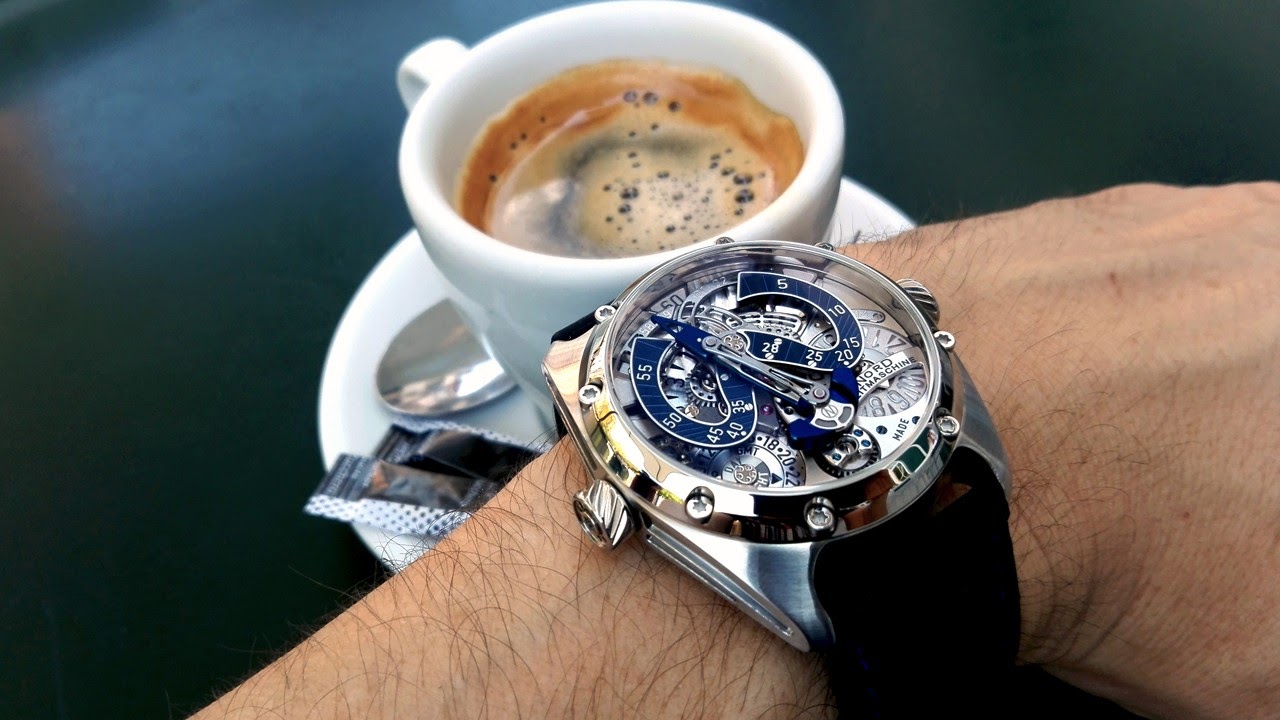
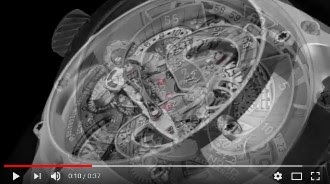
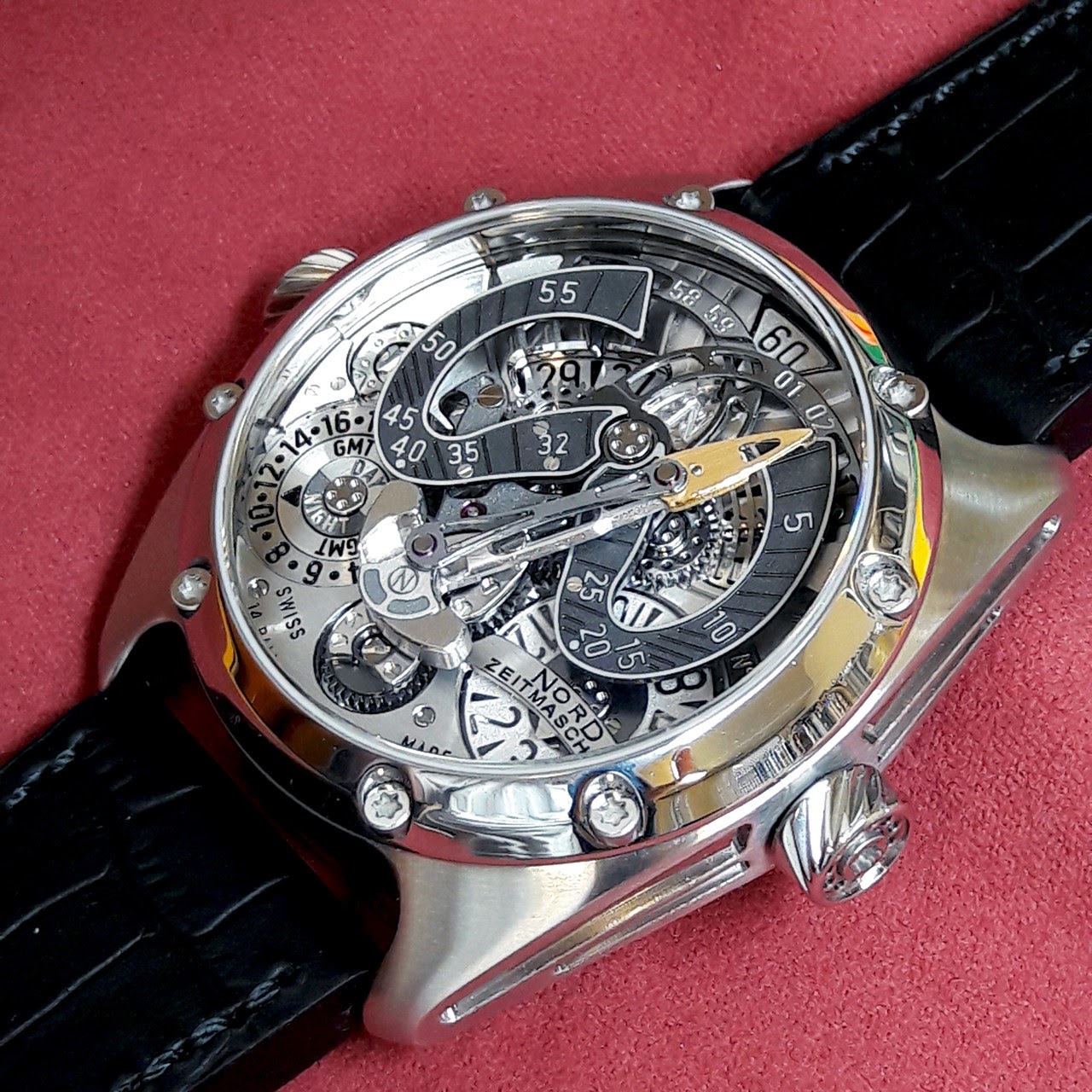
Making it all yourself, with samples showing Freesdial parts
Looking at the three current models offered it is obvious that the parts needed for their construction cannot be bought from the usual suppliers to the watch industry. I tried to find out what particular ideas led to the construction chosen (leading to an atypical visual design), making life especially difficult when the time devices are to be sold to usually quite conservative watch enthusiasts. Most often some hand-drawn sketches show the development of these ideas. None were available from Daniel Nebel since he develops ideas in his head, and when they are concrete enough, he starts with the construction work right on the computer. He then does also not file ideas not carried forward because he is only interested in what he manages to present at the end of the process, which is finished when he is happy with the result. There is no market research or influence of a sales department. The consequence is very authentic watches, he can explain to you in every detail, why it had to be done exactly the way it is. Though, it’s an engineer’s reasoning; all the parts have to be sturdy and built to work preferably maintenance free for 100 years. Daniel Nebel would also be very disappointed about his work if even the first parts produced with the data generated worked not perfectly. The prototype should therefore already show and perform like the series production watch to make him satisfied with his own work. If you want it this way, there is no other solution than doing it all yourself.
The design of the visuals as well as the technical construction is done with Autodesk Inventor software. This was a considerable investment, but provides excellent value by making the work ahead of the parts production so efficient. Since Daniel Nebel is one of the watchmakers being pestered by me for a world time or time zone complication in one of his watches, he surprised me at my latest visit with an idea for a completely new time zone display. Based on this, he demonstrated to me also how easy (for him!) it is to develop a complicated mechanism on the screen. I must have sat there with open mouth because I realised that with such skills there is also not the risk to just duplicate and slightly modify what is already available on the server (which is the argument for many designers to insist on hand drawn idea sketches to be done first, since they believe otherwise nothing truly new will be created). Daniel Nebel, though, does not work with forms or technical solutions already created. When he has developed ideas sufficiently in his head, he starts the drawing phase directly on the blank screen. Starting off with a key part of a new mechanism, he draws this in 3D on the screen without yet considering the exact dimensions. Parts are then added one by one, before entering the second phase. Now the desired functions are simulated on the screen, what will lead to modifications (particularly regarding dimensions) until everything looks like working without undesirable interferences. In a final step the parts are shaped with aesthetic considerations in mind. The chosen form, e.g., of dials can then reveal his interest in motor racing (if you have not already noticed the posters on the walls…), with a shape to look like a race track, as on the Freesdial .
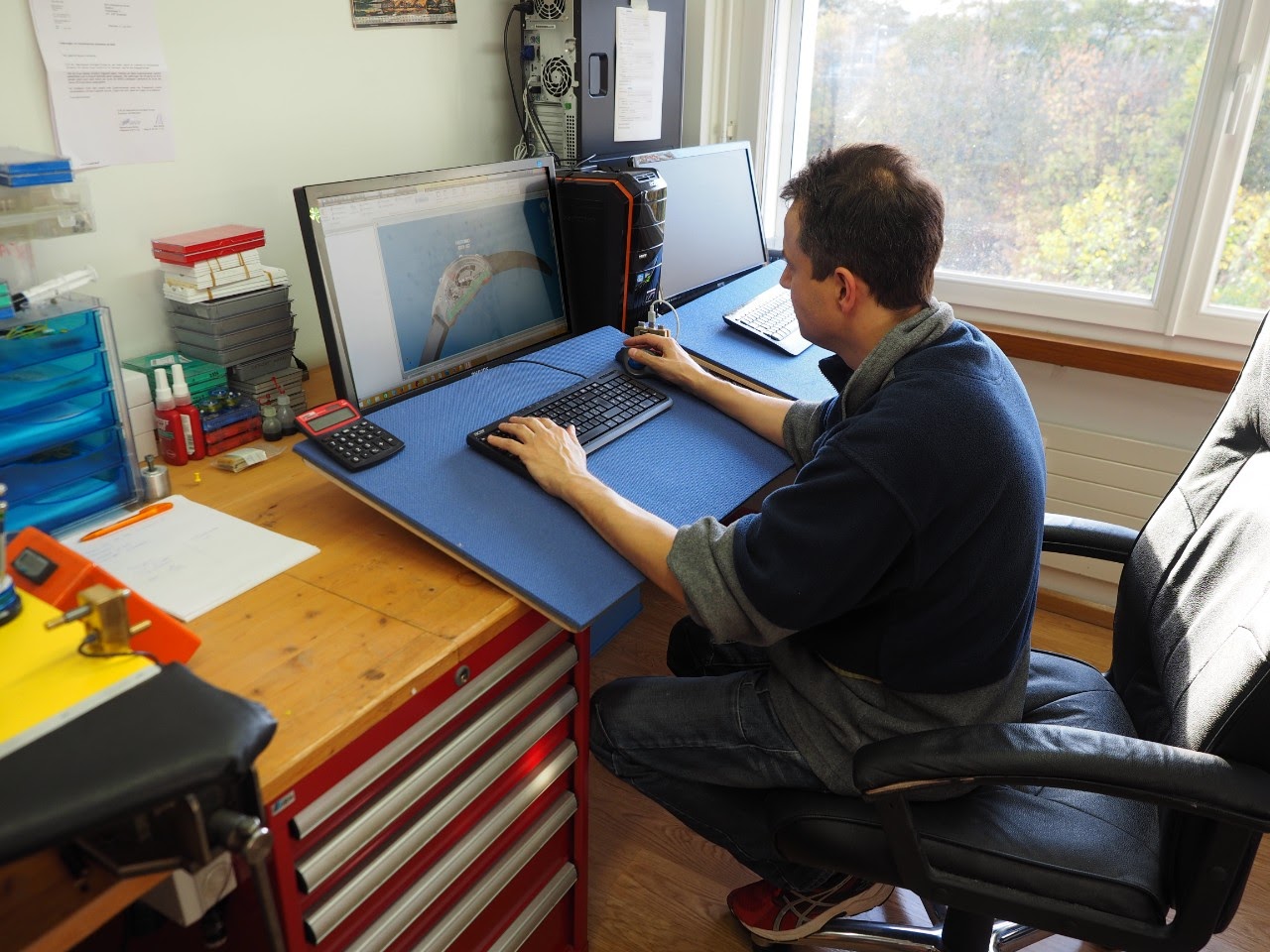
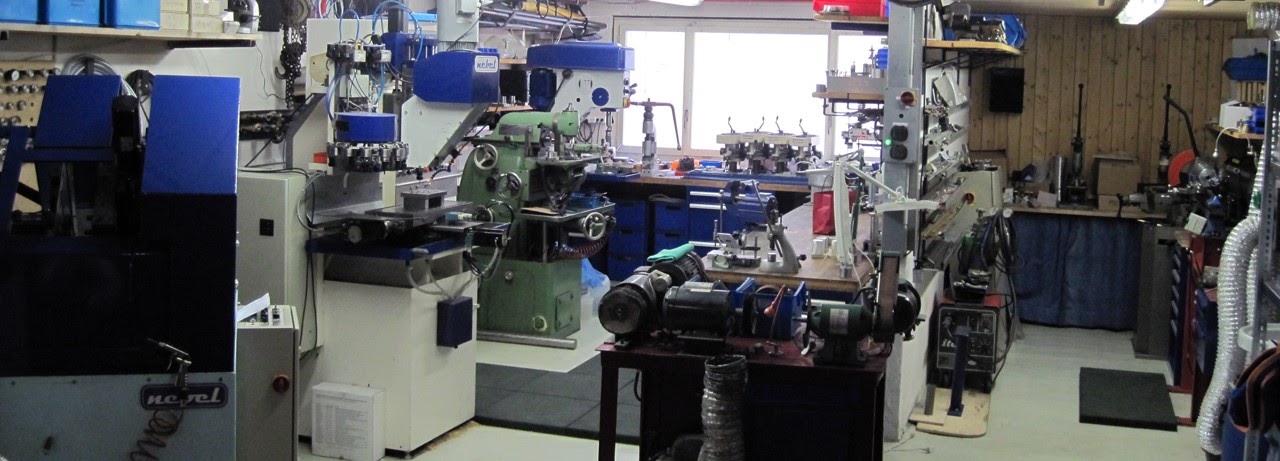
Above: Workshop and material stock room are of a compact size. With a convenient layout of the machines, all the parts required for the watches can be produced here. The construction office cum atelier is in a different building.
Below: In addition to the CNC mill, the ingenious CNC lathe is also self-built. The main spindle (LH) is automatically fed with a bar of raw material from behind. Visible in the background is one of two tool carriers, fitted with six different milling spindles; when these tools are in operation, the main spindle is standing still and is blocked. The second tool carrier (RH in the foreground) is equipped with rotating and drilling tools. With this versatile lathe the parts can be worked on with a multitude of tools in three axes, with an ideal workflow to be programmed. The advantage is a part staying fixed all the time in the same position on the main spindle. This is not only sparing Daniel Nebel to construct additional fixing tools for further treatments of the part outside the lathe, but ensures absolute precision, with one part being exactly like the next one. This efficiency (in addition to uniform precision) is most important in the production of the parts. Not only does he spend 80% of his time in the workshop, it is (according to him) also the only part of the watch production where a clever organisation of the work processes can gain you relevant time. In decoration and finishing as well as in the assembly, speeding up the processes is almost impossible without losing quality.

For Daniel Nebel it is simply not possible to build complicated modern watches without relying on these machines (what is also stated, e.g., by Kari Voutilainen who covers the high-end part of the watch industry with his offerings). If your ambition as watchmaker goes further than producing the odd bridge or plate and working for days on hand polishing bevels and inward angles, investment in CNC lathes and mills as well as mastering CAD seems indispensable. Or then you have someone else produce all these parts for you, or you buy-in ebauches/part kits. When I see in the promotion only watchmakers working bent over some ancient small machines, I remember that “in-house” means a lot of different things in the watch industry! In 42 working years, George Daniels only managed to make about 37 watches (the Millennium and Anniversary series wristwatches were built with/by Roger Smith). So, his methods for real hand-made parts production has its limits.

Above: With at least 300 different parts made in-house from raw materials for the three watch models, Daniel Nebel can handle the production only within the time the days of a year offer him by doing them in reasonable quantity batches. This brings the necessity of rigorous stock control with it, to avoid being stuck with the non-availability of a tiny part in an otherwise complete watch ready for delivery. (Copyright photo: Timm Delfs; image used with permission of author)
Being able to produce the required parts in your workshop is not yet the end of it because Daniel Nebel builds also himself all the tools required for detailing and assembly work.
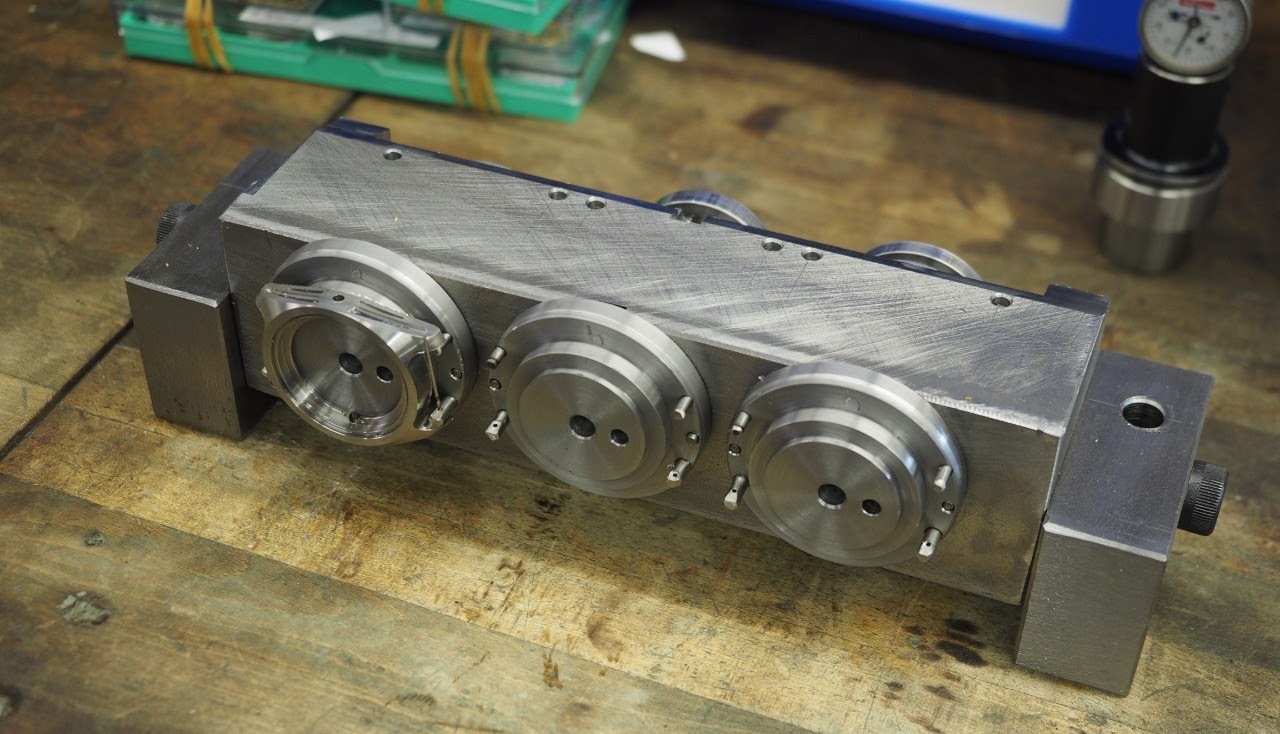
Above: To precisely drill the non-through holes on the inside of the lugs for the spring bars of the Freesdial , Daniel Nebel has created a “heavy-duty” tool precisely guiding the drill to have a clean-cut hole always at exactly the same place.
Below: This three-part tool ensures that only the tiny milled recess at the end of the moveable dials is blasted with a medium to add surface structure and with it variety in the light play of the finished part.
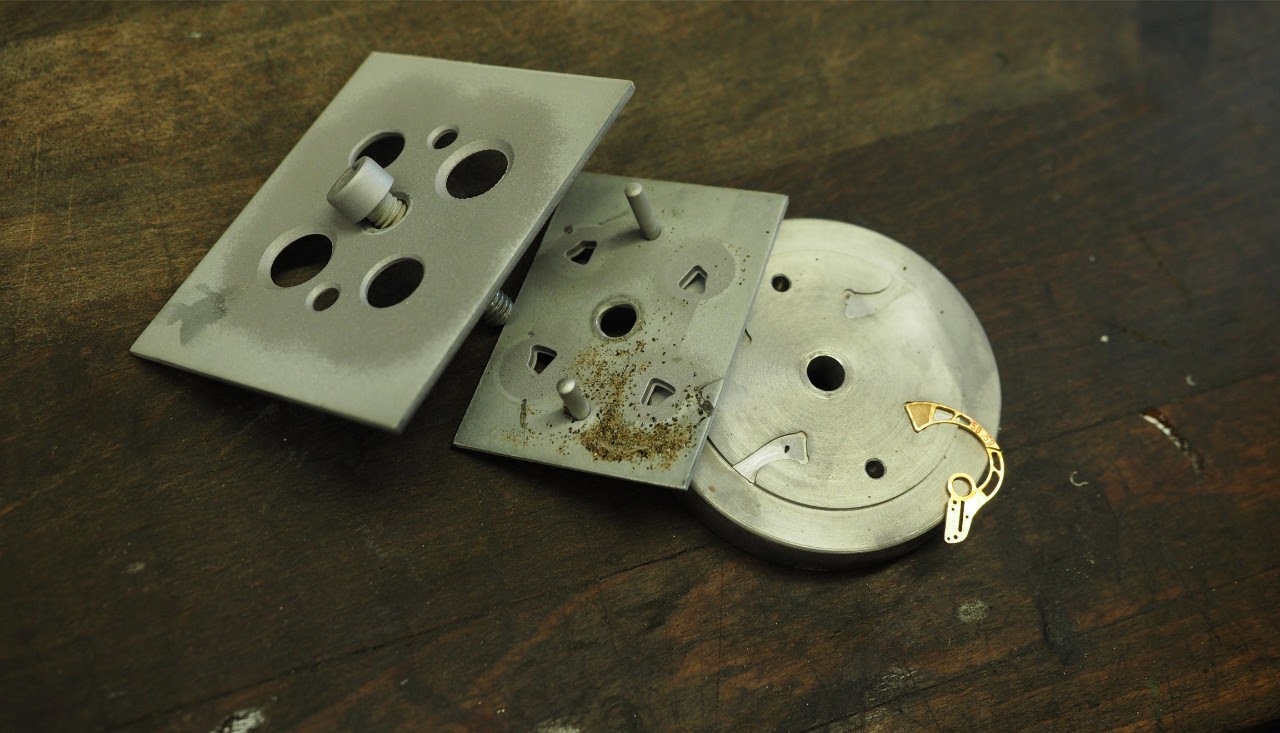
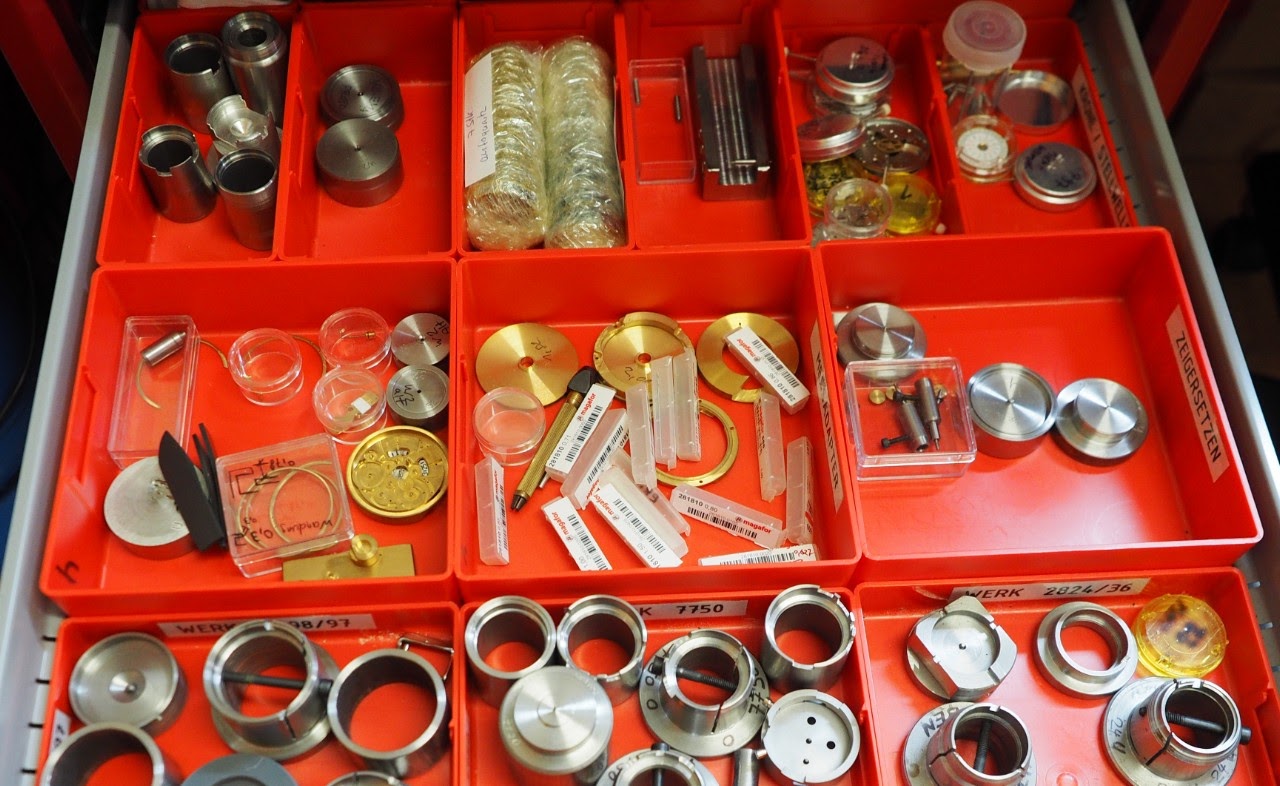
Above: The drawers around the watchmaker’s bench are also full of self-built tools. As an engineer Daniel Nebel wants to avoid any quality issues with the assembly work due to a variable daily form of the watchmaker. These tools help, e.g., to avoid skewed inserting (or undue side load pressure when fitting) of rubies, pins or other tiny parts to the subassemblies of the watches.
Below: With the quantity of all the different small parts required in the watches and their subassemblies, everything got precisely documented. Defined are fitting tools to use, how to insert a part (e.g. ball bearing), and all the relevant measurements of the assembled part.
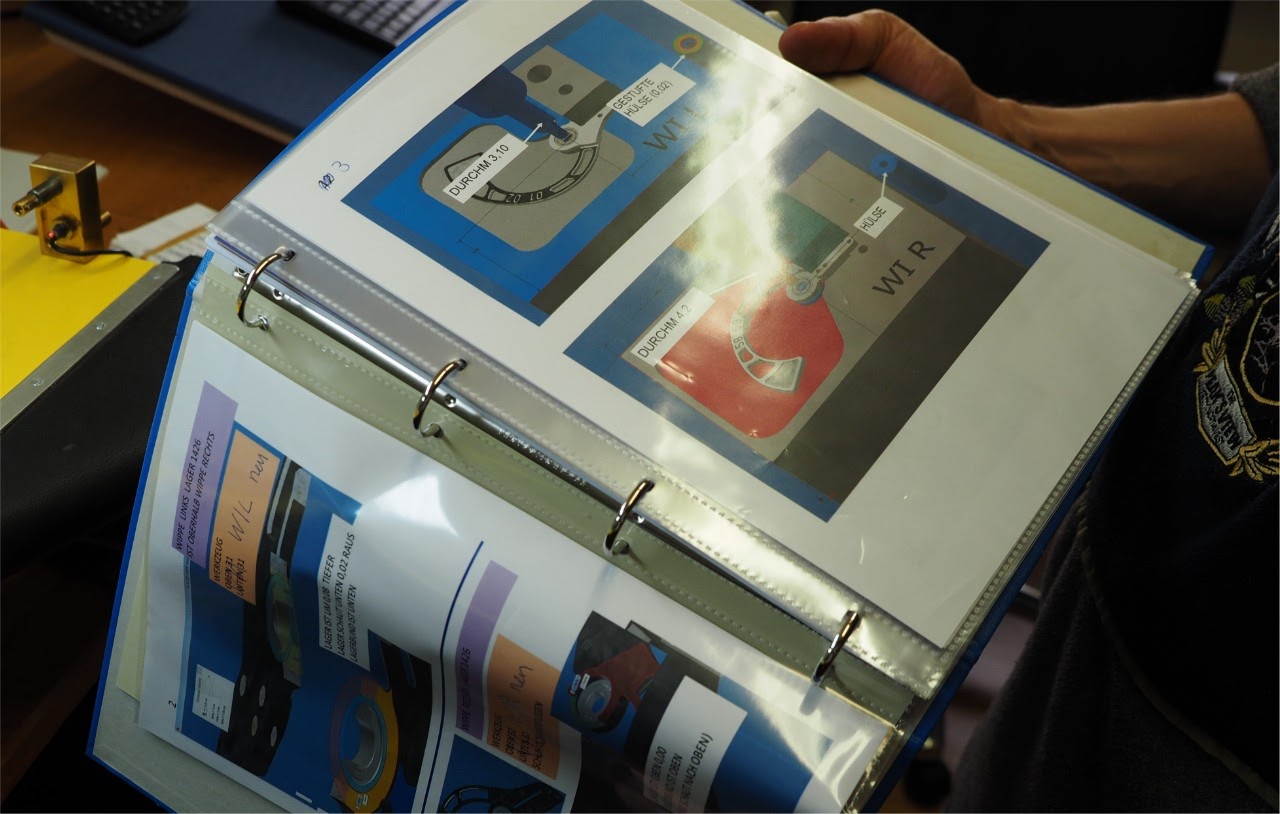
Being shown the construction office/assembly atelier just confirmed how incredibly organised and disciplined Daniel Nebel goes about building his watches. The measures he has taken to ensure up-keep of the highest quality at any time and every stage, was a real eye-opener. What I saw was an industrial quality control procedure to build just around 30 watches per year, and with the one person doing all the work. If this is not comforting for the buyer, I don’t know what it can be.
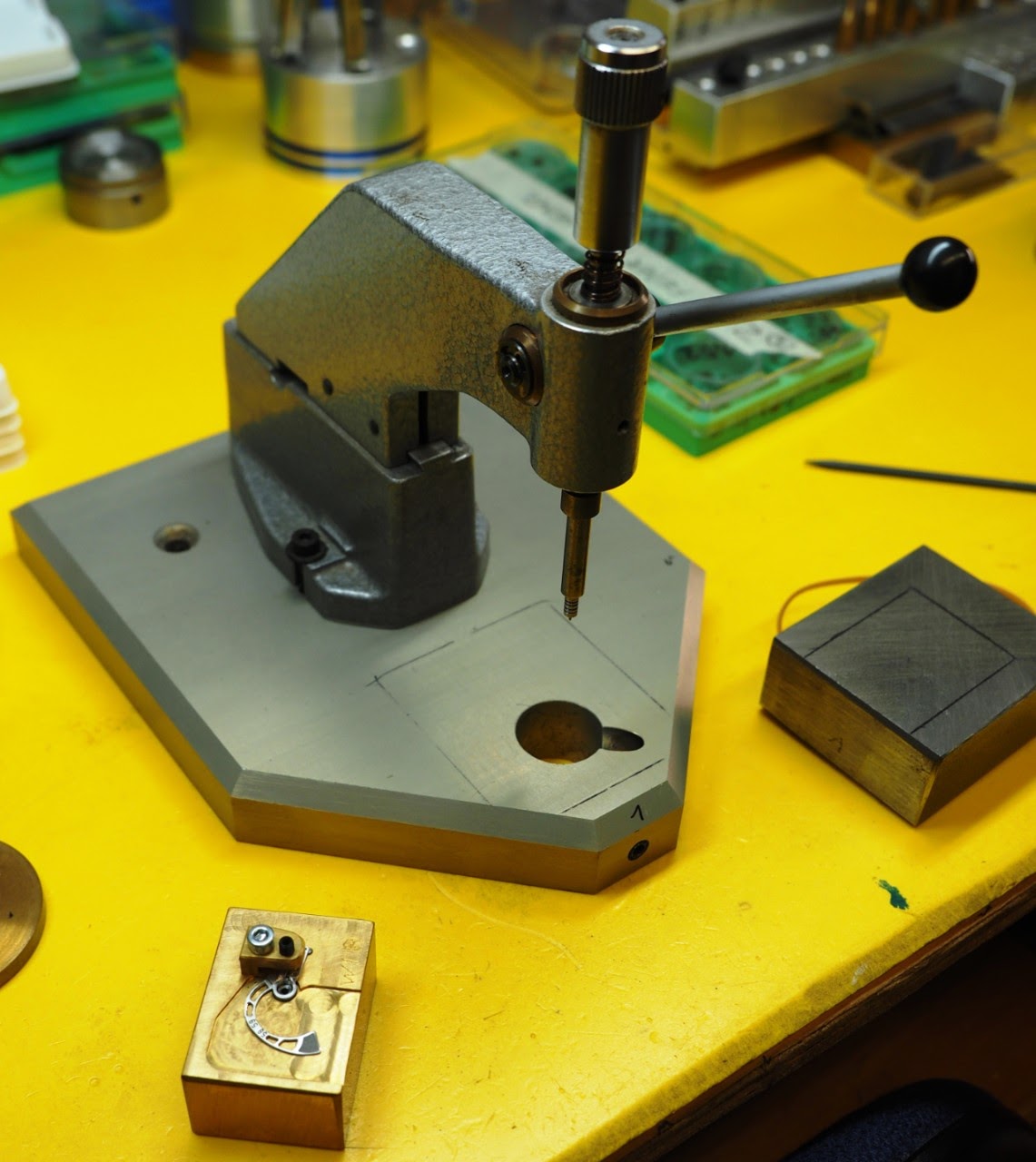
Bought-in are the ETA base movements, sapphire glass, a part of the screws, ball bearings, rubies and straps. Everything else is truly made in-house. Regarding the cases this is not the norm in independent watchmaking. For fairness sake it has to be mentioned that the problem of reclaiming precious metals in an environment mixed with brass and stainless steel is the main reason elsewhere for using suppliers. Daniel Nebel offers only cases in 316L stainless steel, so there was never a question to use an outside supplier.

Above: LH – The blanks in 316L steel (RH part) come to Daniel Nebel pre-turned by a local supplier; 1st work stage finished, i.e. conical turning of lugs (LH part). RH – The first treatment is turning the conical shape of the lugs on the lathe.
Below: LH – Next process is turning the flanges (finished part on LH) on the lathe. RH – From the lathe the cases in the making are moved to the mill to create the contours; in the same operation the holes for the threaded bushes to later screw on bezel and back are drilled.


Above: LH - Back on the lathe, the exact fits and tolerances are machined, including O-ring grooves. RH – The result of this operation is a case ready for the internal machining.
Below: LH – Now back on the mill, the required room for the GMT display, GMT setting mechanics, crown and bottom plate of the module is created. RH – After fitting the indexing unit to the mill, Daniel Nebel gets the fourth axis to now machine the flanks of the case, including the decoration recesses.


Above: LH - Still on the indexing unit of the mill, the holes for the two crowns are drilled. RH – The final jobs of deburring, satin finishing and polishing are then also all done by Daniel Nebel himself.
Below: The finished case of the Freesdial . The unusual shape integrating the lugs in an almost horizontal line avoids a case looking like a cut-off barrel, as often seen when the movement requires an important height.
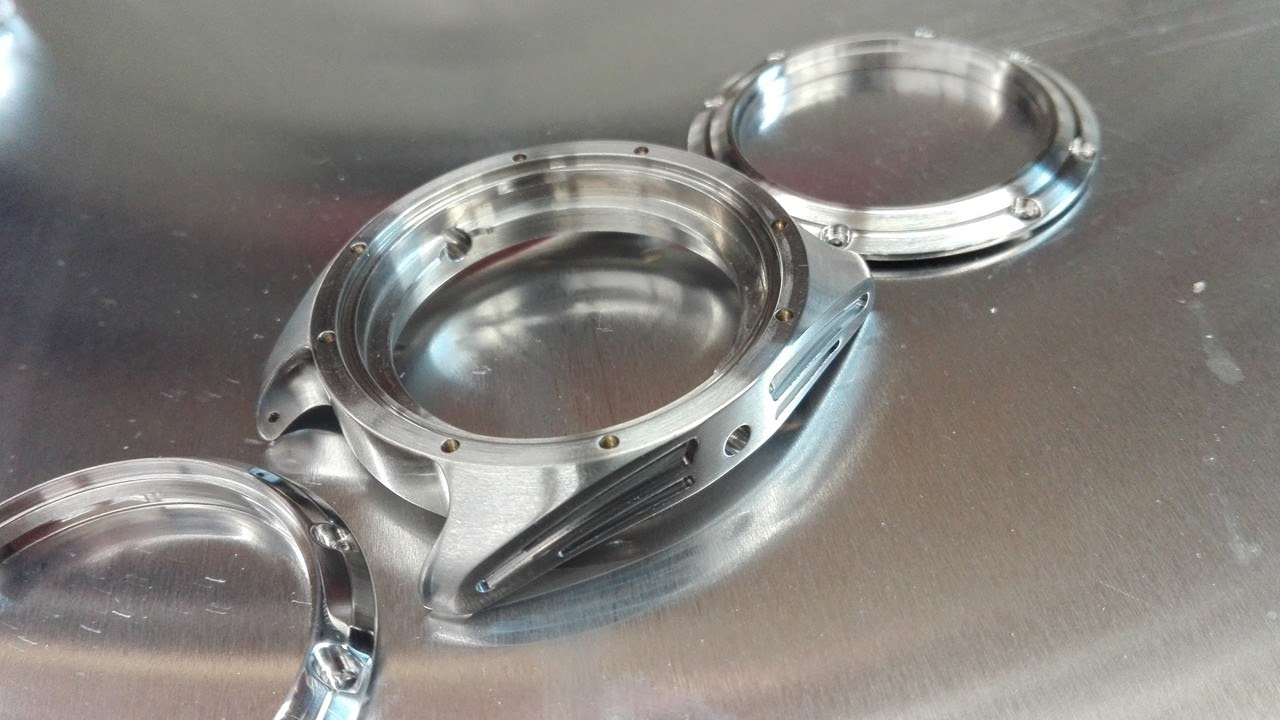
Shown in abbreviated form was only what it takes to produce the middle part of the case. The same effort has also to go into the production of the front and back bezels, as well as the two intricate crowns required for the Freesdial model.
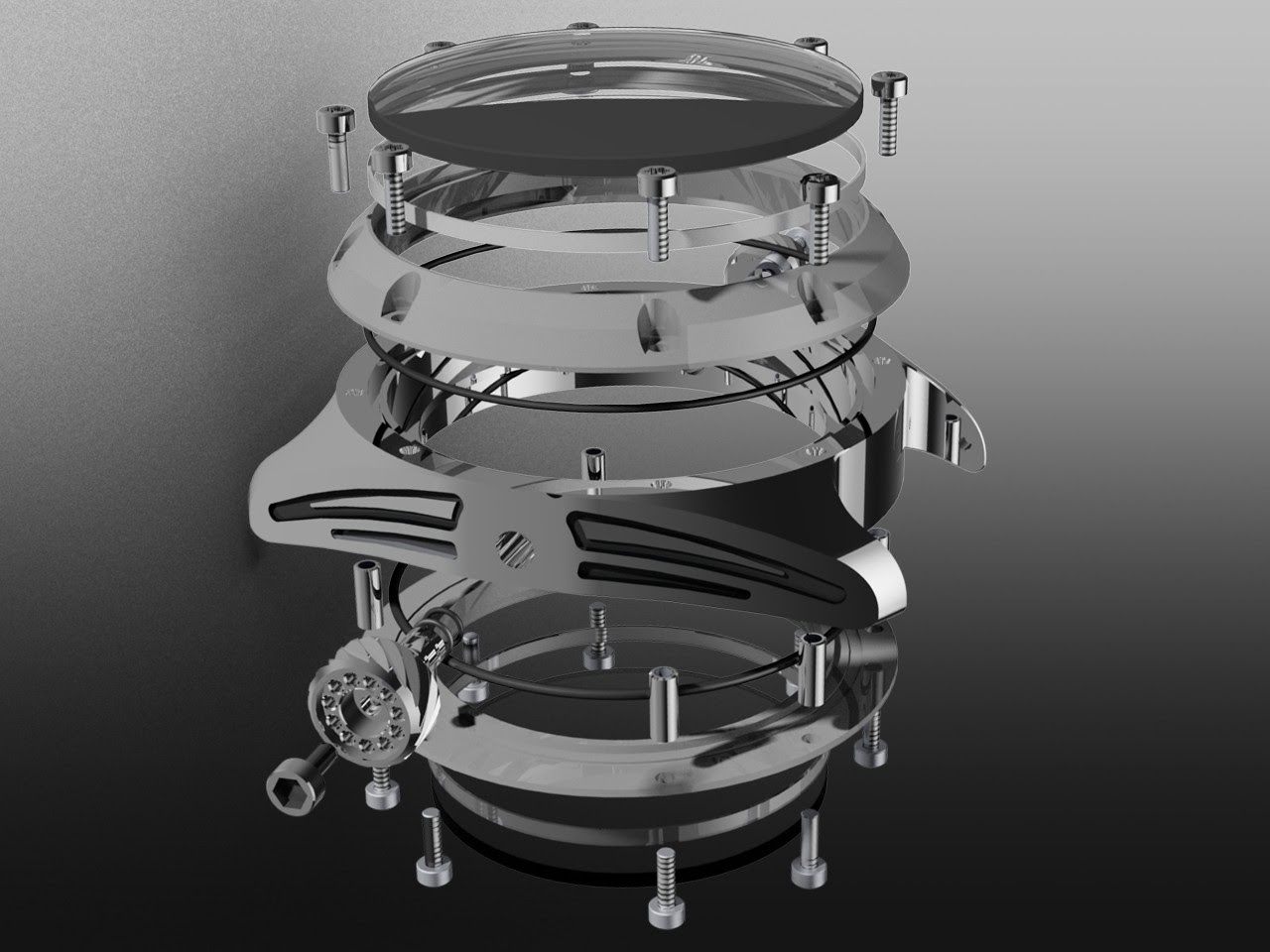
Below: And who in his right mind thinks about producing strap buckles in-house with all the suppliers available on the market? Daniel Nebel offers you also these parts milled from solid blocks of raw material and then assembled from 11 separate parts. Well, looking more closely at these buckles, I can even understand this insane effort. They perfectly match in material and design the watches and it would indeed be a pity to destroy the coherence of it all by using a mass-produced thin-walled standard buckle. That not everybody might see and appreciate these endeavours does not frustrate him, since (again) he would never be happy with his own work if the slightest compromise sets in.

There are around 120 single parts in the module of the Freesdial . Every one of them has to go through several steps in its production. Used here as sample is the bridge for the intermediate wheel:
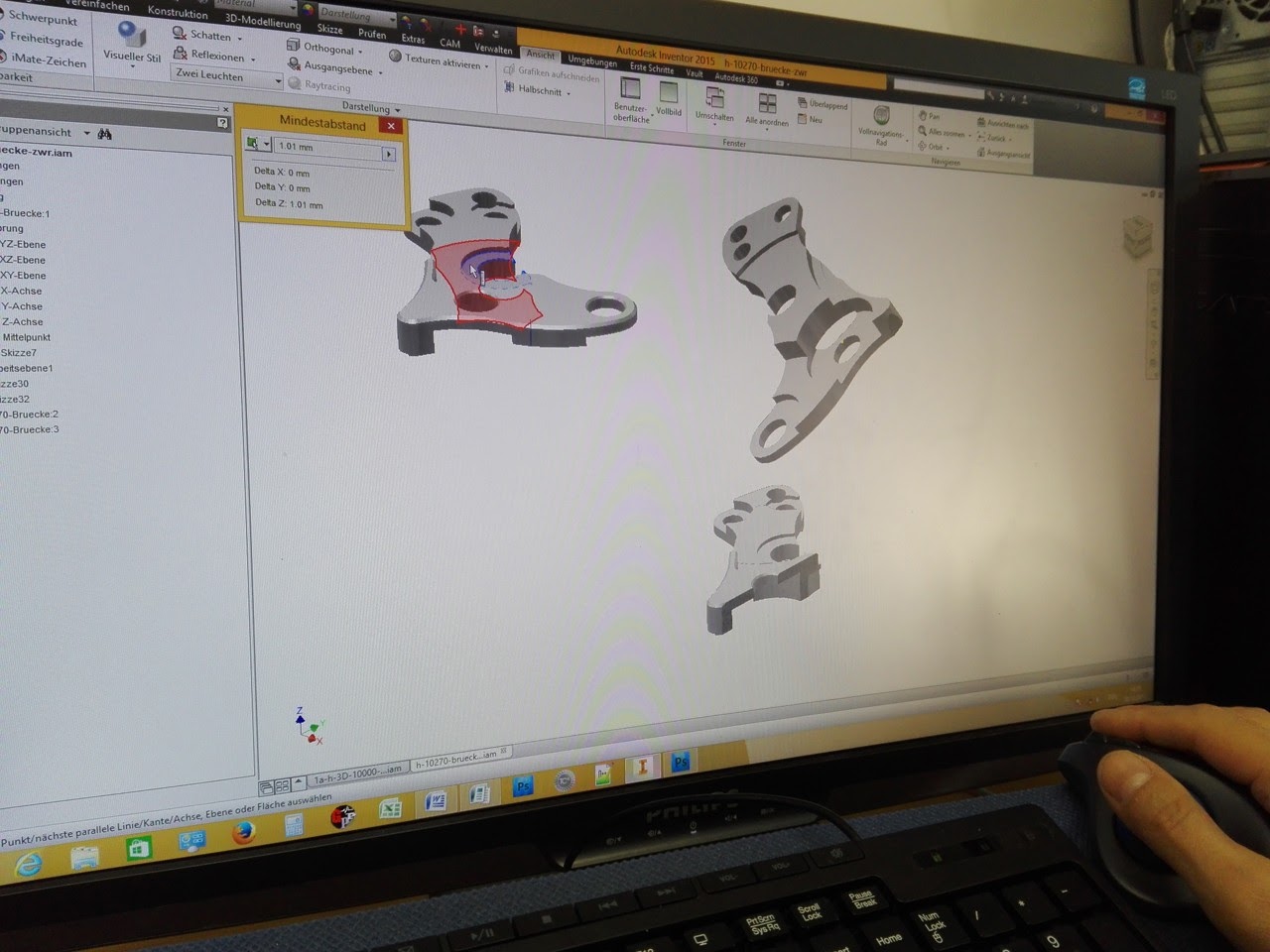
Above: The part is first constructed in 3D on the screen with the Autodesk Inventor software…; Below: …then changing to the CAM environment, tracks and areas for the milling tools are defined for the software to create the CNC codes. Next step is to convert the CNC codes into a CNC ISO file for the lathe or the mill.
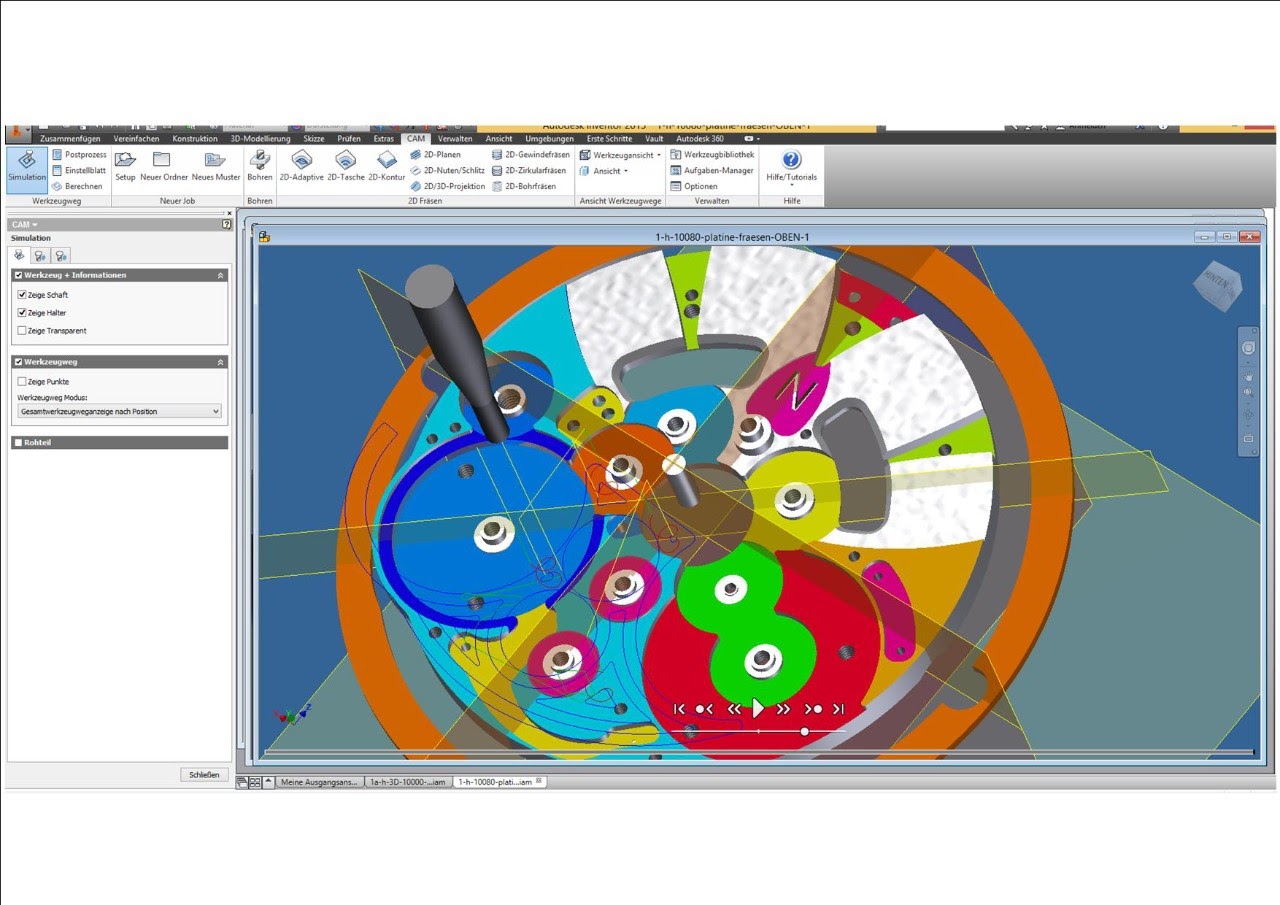
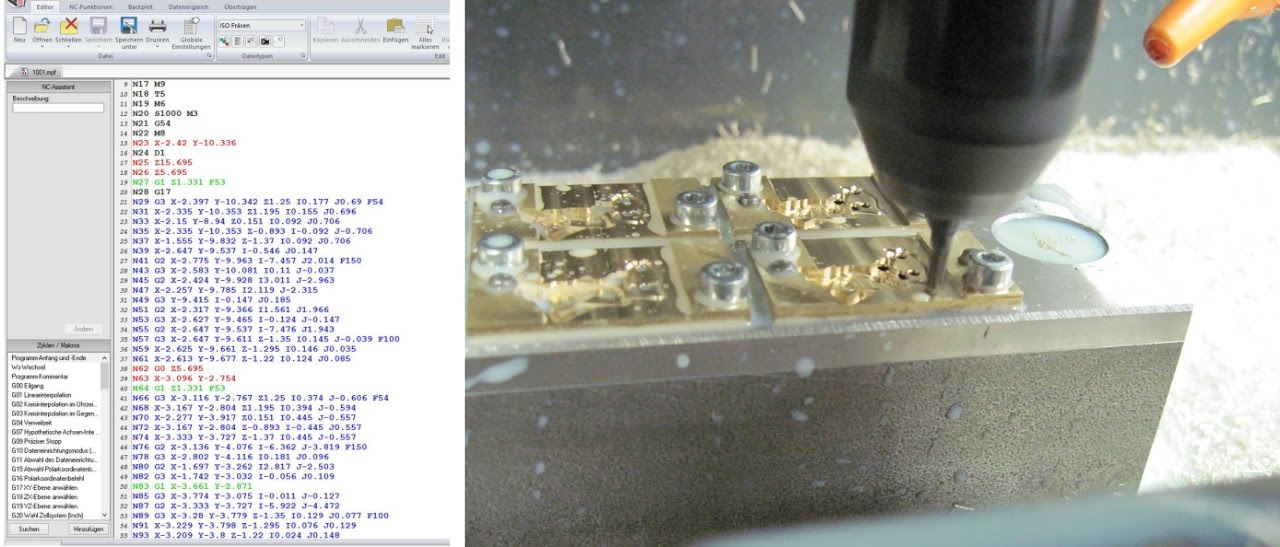
Above: Before the actual production starts, based on his experience, Daniel Nebel works through the proposals of the CNC ISO file and amends manually in the program whatever he feels improves workflow and/or quality of the parts right from the machine. The bridge used here as sample is then milled from a solid block or sheet of brass which itself is mounted on a solid carrier plate.
Below: The precise positioning of the brass sheet is so important because the bridge is milled from the back side and then from the front side. At the end of this process the bridge stays only fixed with a narrow stem to the remainder of the brass sheet. As long as this fixture exists, all the holes are also drilled on the mill. Only then is the part broken loose and the remainder of the brass sheet (the biggest part of it) scrapped.
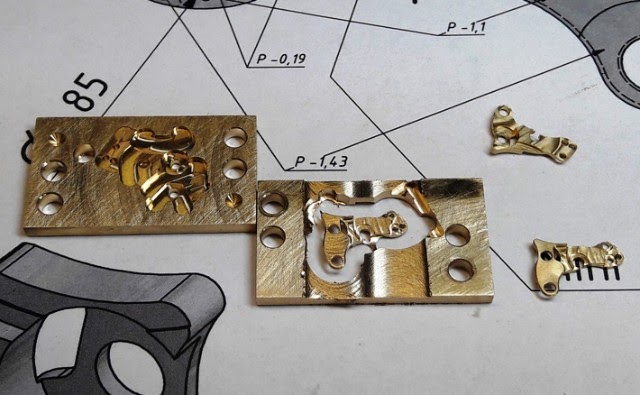
Below: LH – Coming from the milling machine, a lot of handwork starts: First the deburring, then sand blasting, and finally the anglage of the edges. RH – After this mechanical detailing, the part is ready for the galvanic treatment.

Below: Galvanic plating of the parts is also done in-house. At the time of my visit this “department” was not in use. Due to space restrictions in the workshop and the absolute cleanliness required for the galvanic processes, Daniel Nebel sets the bathes and the further equipment only up from time to time and treats then a stock of parts in one go. I learnt that there are also quality differences in the solutions you can buy already set up. He takes, of course, only the best available for the size of his facility.
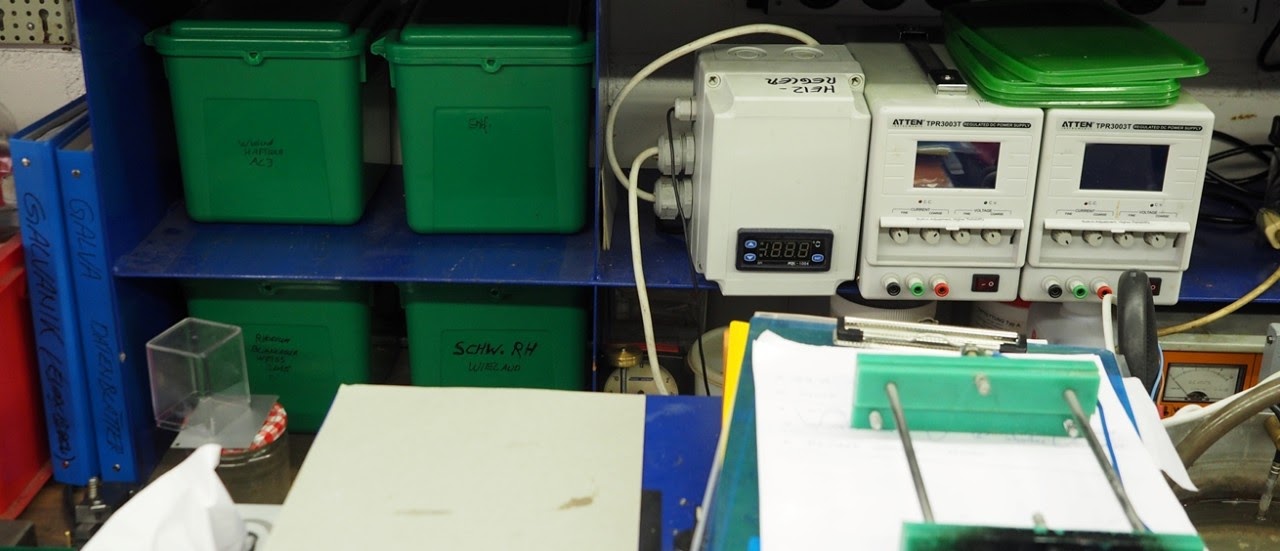
Below: Yellow gold (2N and 3N), rose gold (5N),”black” gold and rhodium plating (“white” as well as the anthracite coloured version) is offered. PVD blue has to be done by a supplier. First all these parts are pre-plated with an adhesive gold (looking like yellow gold, 1st from LH) for a more durable protection. Other manufacturers might plate the brass part (2nd from LH) with its final layer – like “black” gold (3rd from LH) or bright rhodium (1st from RH) – right away.
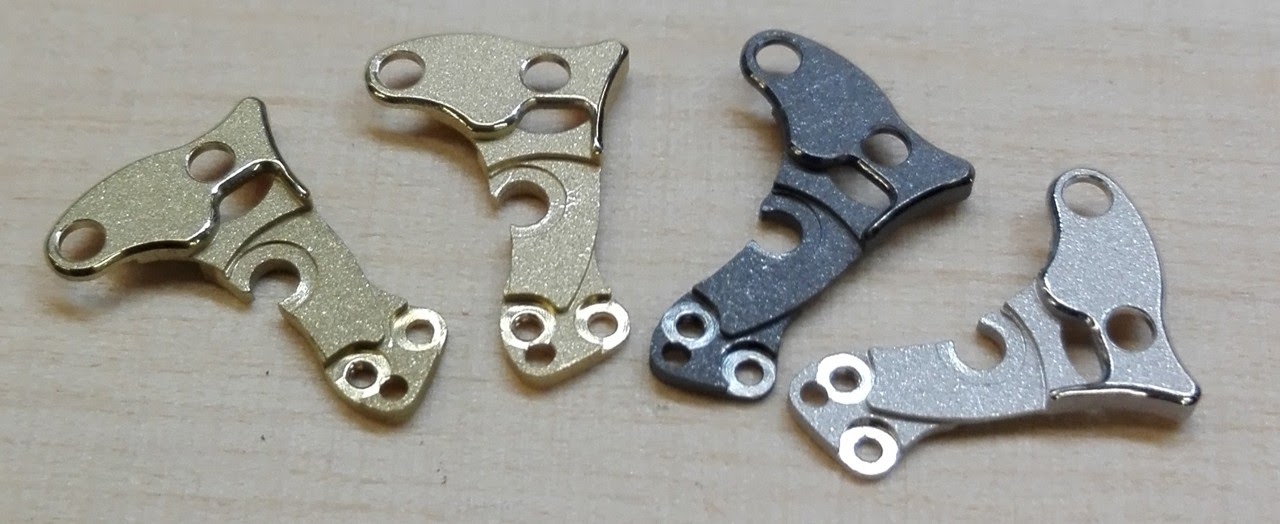
Below: When the rubies are pressed in, the bridge is finally usable in the watch and is transferred to the atelier for the assembly work in a clean environment. Now the other 119 parts required in the module for the Freesdial have to be produced and to follow to the watchmaker’s bench.
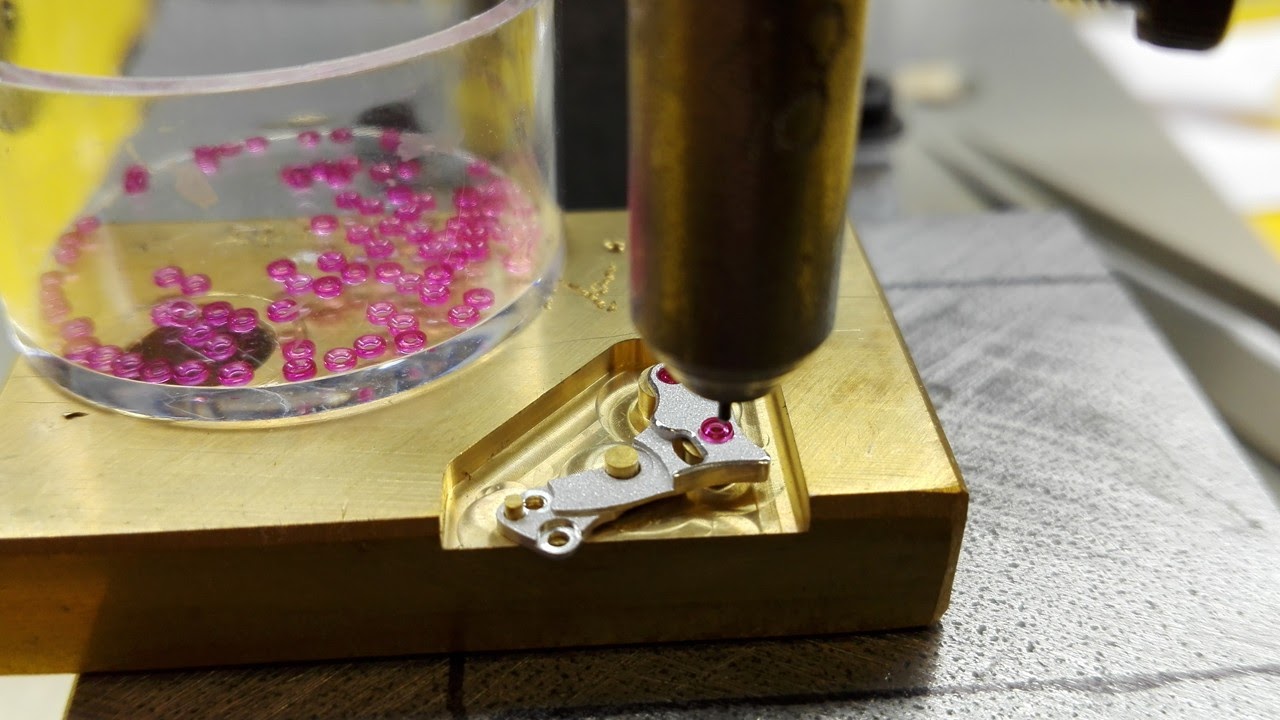
Below: While Daniel Nebel mills most of the numerals and lettering, there are a few printed surfaces. Even this is done in his workshop, with a small industrial pad printing machine. He has motorised it, to get rid of the tedious manual operation moves. With a suitable process, he tries to get the third dimension even into print. He explained that first several print cycles have to be done at a slightly reduced size of the numerals or letters to be put on a piece, to build up enough paint material. A final printing cycle is then in the designed size to ensure sharp edge lines of letters and numerals.
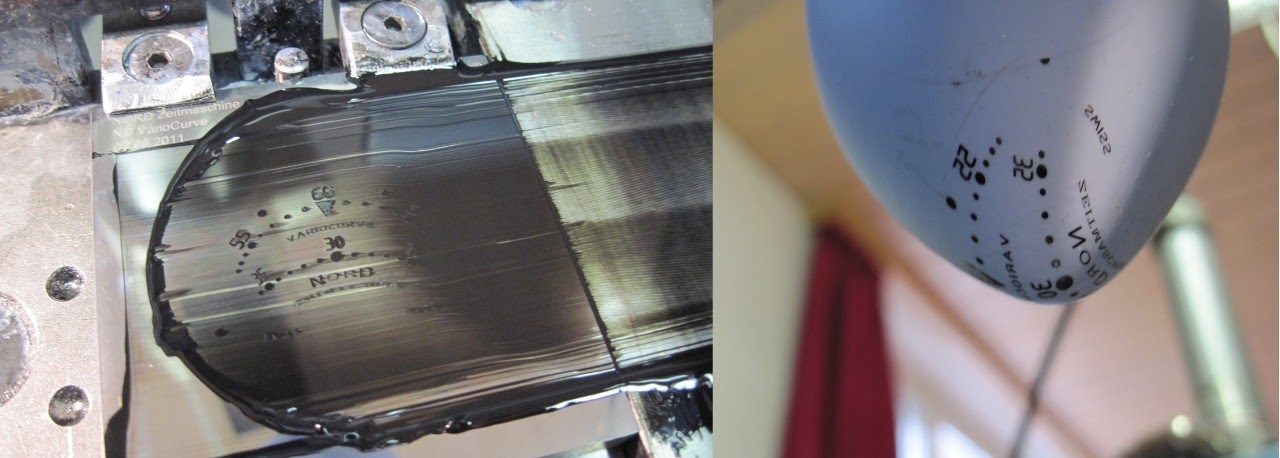
What I love particularly with Nord Zeitmachines is the third dimension found prominently on practically every part. This is enhanced by different surface treatments. The hour disk is a good sample: There are the raised numerals/markers and edges, polished and painted, with the milled recessed surfaces blasted and rhodium-plated. The numerals on the GMT disk are milled and filled with paint. Elsewhere you might get such displays just as print on thin flat disks.
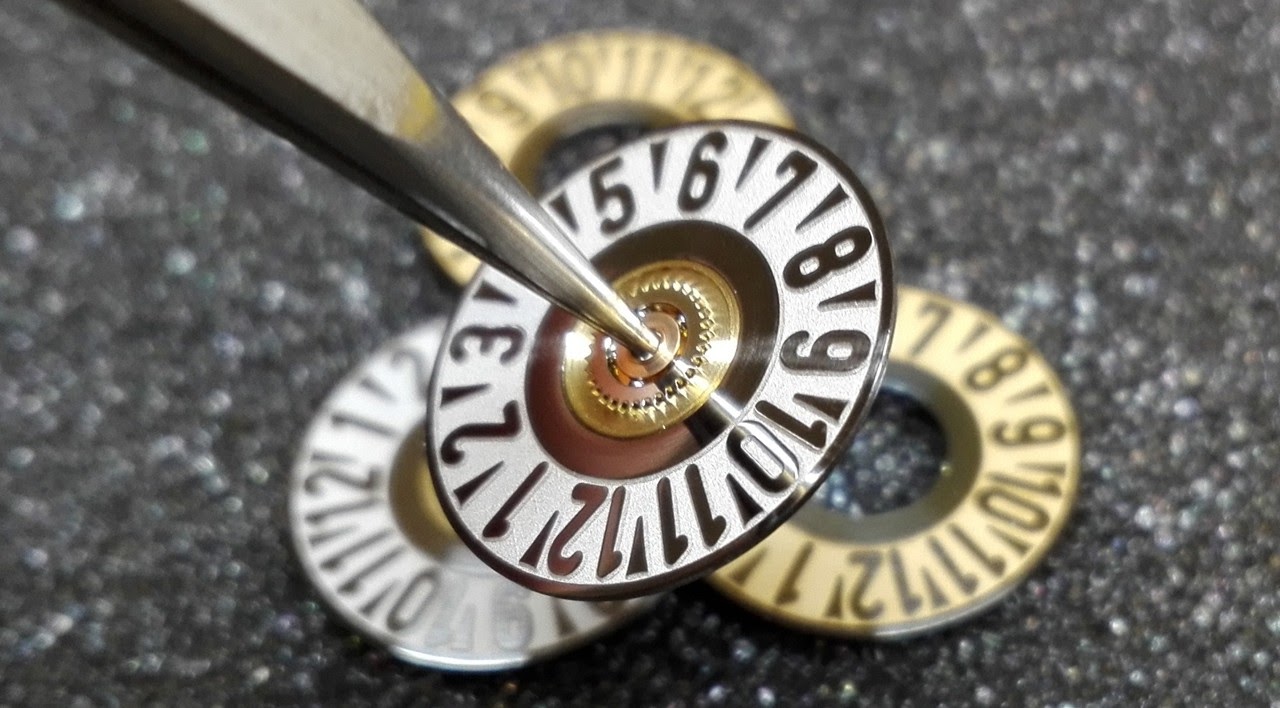
Daniel Nebel offers also the bevelled and polished edges of the traditional watch making on some parts. Though, he is not hand-filing and hand-polishing with wood sticks inward angles. His proudness comes from engineering principles employed in the best possible way. This includes the choice of the base material used, working with the best quality tools, choosing the right production sequence and working speed of the machines, all to get quality parts in an aesthetically pleasing shape right in the production. Making a part so well that there is not any hand-finishing to be done would be workmanship in its truest form for him. Since most of the parts used are of a substantial (in watchmaking terms) thickness and not spread out in the watch, but tightly fitted as in a machine, I believe the typical hand-anglage of fine watchmaking applied here would look odd.
The detailing chosen looks for me absolutely fabulous in the finished watches. There is a fascinating play of light with the different surface treatments and surface levels of the parts. Charring pieces (like paper-thin levers or bridges), often to be found in open-worked traditional watches, are absent. The basic idea to build a “machine” is supported by a well-considered architecture of the parts, giving the movement respectively module a great depth. The oversized wall thickness of the parts (enjoyed in machine building for the sake of stability) makes it possible to taper them for a more elegant look, enhancing the unique three-dimensional visualization of the construction. And you can see a lot of the ingenious mechanics behind the time displays offered, without reading the time being hindered. For me the Nord Zeitmachines are therefore not just gimmicky kinetic artworks, rather a kinetic spectacle combined with the finest watchmaking.
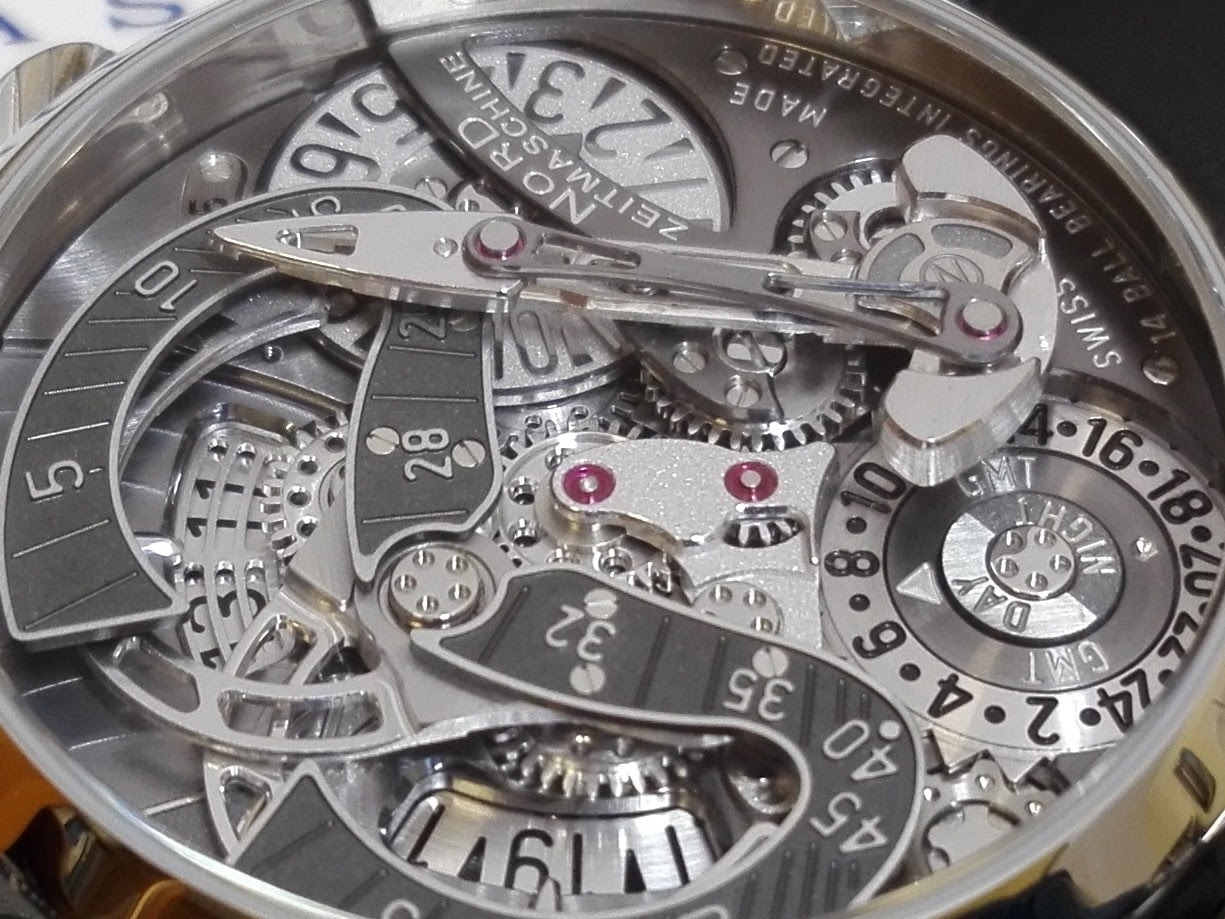
For once, “in-house-made” is to the max with Daniel Nebel. He starts with his own ideas and constructions as well as with the raw materials, and carries through to all the decorations, finally also building all the watches himself.
Already in the prototyping phase testing is also not neglected. One test is to ensure a waterproof case. The case itself provides usually no problems (the thick walls of the Nord Zeitmachines would be good for up to 500 meters); the use of high-quality seals as second factor for waterproofness is also common practice in quality watches. The deciding factor is usually the glass used. By using atypical thick glasses, Daniel Nebel continues with the over-engineering of his construction. In his pressure chamber he wants to see the glasses fitted to his watches to withstand easily a pressure of 15 bar (i.e. 139.5 kg relating to the size of the glass used) for at least 30 minutes. While he quotes waterproofness to 100 m in his literature, the Variocurve case (for example) is effectively good for around 170 m.
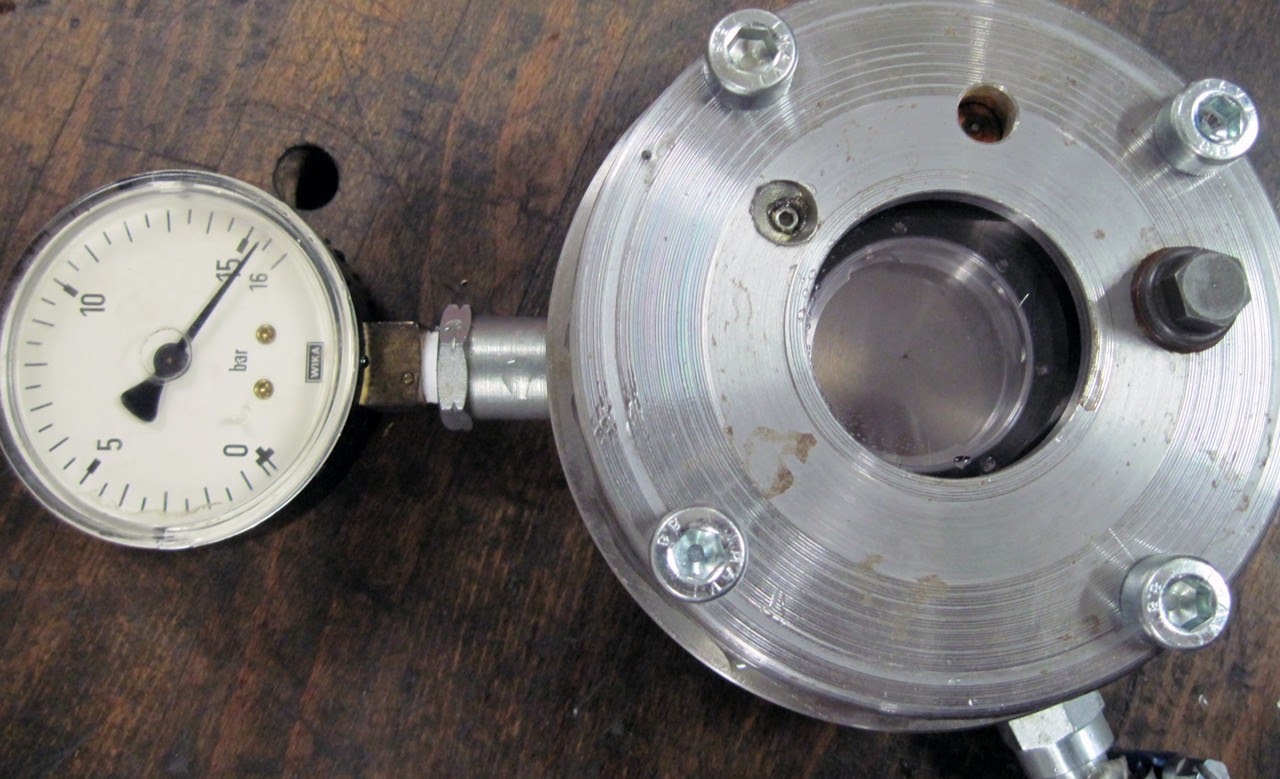
When the watches are built, they are first regulated to +2 to +7 seconds per day on the Witschi timing machine. Afterwards the fully built watches come on a self-built testing rig for seven to ten days. This machine simulates the typical movements and positions the watches have to endure on the wrists of very active owners. The watches are only good for delivery when the precision is the same as on the Witschi after these additional tests. Otherwise the adjustments and tests are repeated.
For me it is incredible, with what stamina, precision and organization Daniel Nebel goes about his watchmaking, and all combined with boundless enthusiasm. Experiencing this it gave me a kick in my own back, when I had to recognise that there is scope in my own job to improve on work discipline.
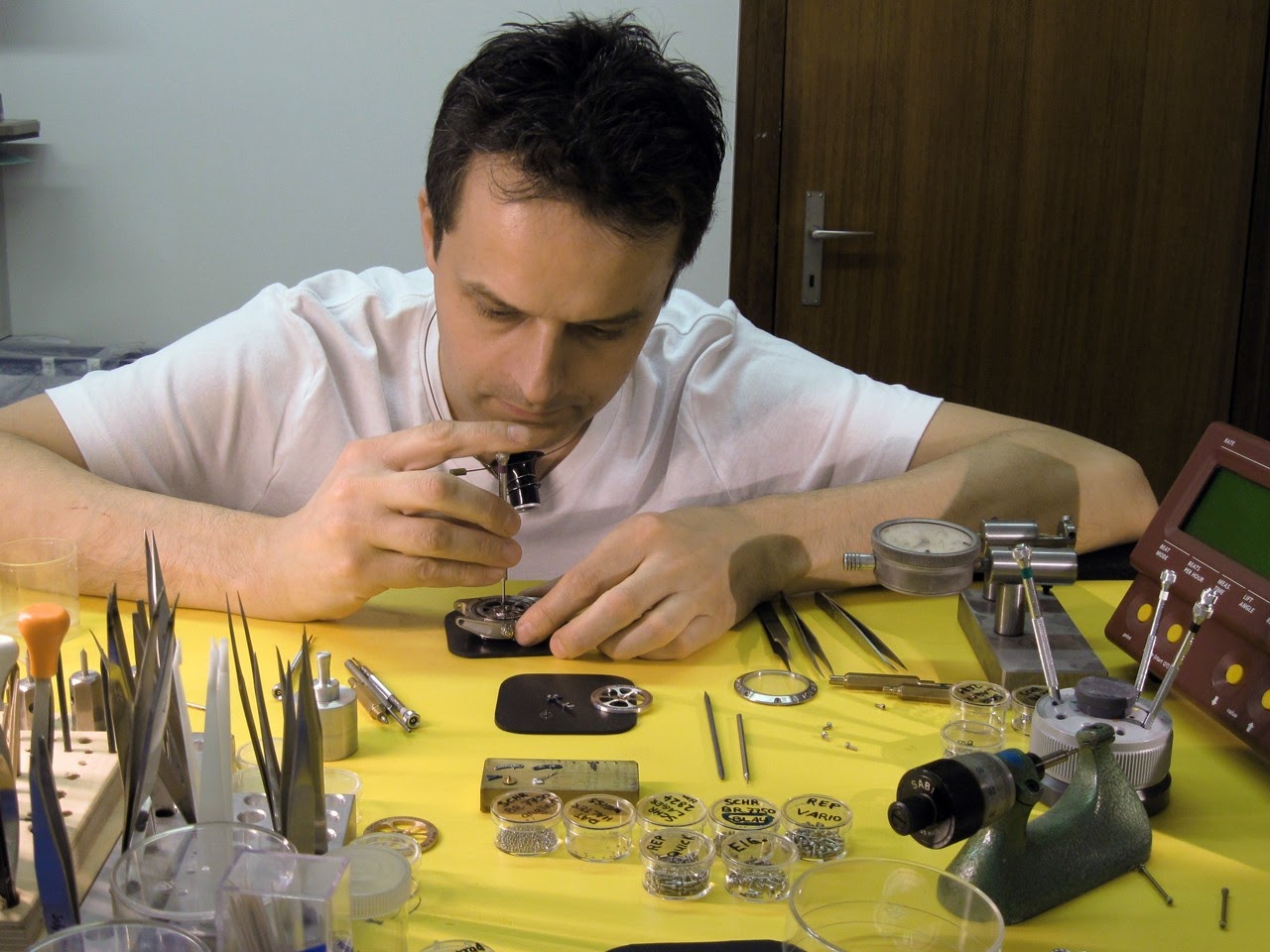
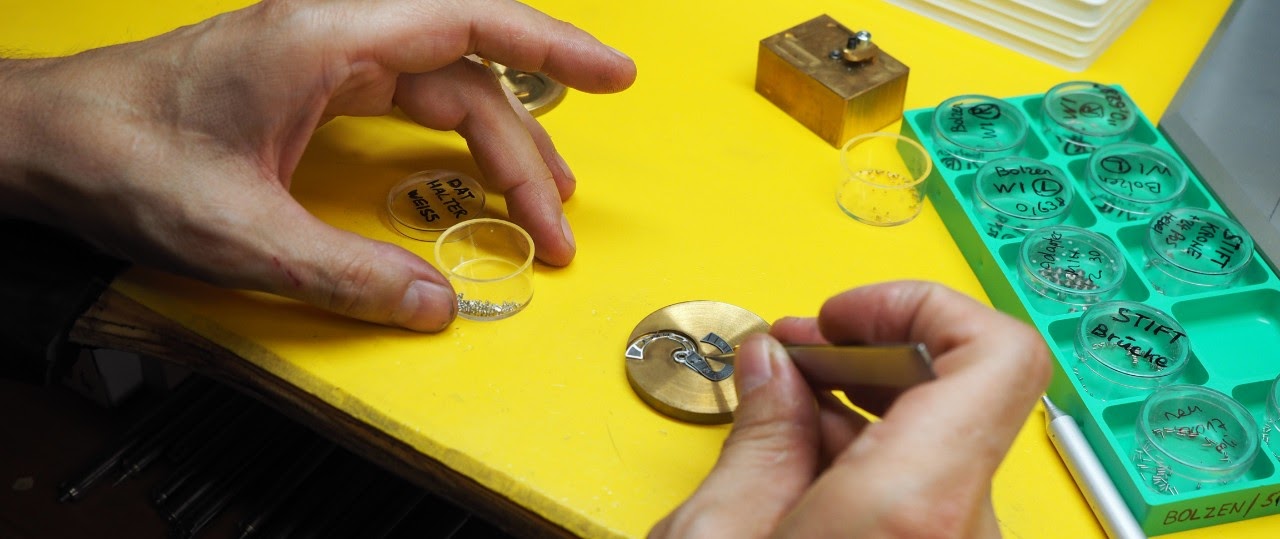
Unfortunately there is no time left with the workload on hand already that Daniel Nebel can even sell his watches without the help of third parties. Selling is perhaps also the part he would feel uneasy however excellent the product on offer is. He works therefore with loyal retailers almost since he started. He is happy with this situation. But I thought the world to be unfair, when supplying all the material at cost and putting in all the work at a very moderate hourly rate (particularly considering the skills and experience required) earns you only the same amount as the compensation for presenting and selling the watches to customers, particularly considering the still moderate (in view of what is offered) price level Nord Zeitmaschines are sold at.
What next?
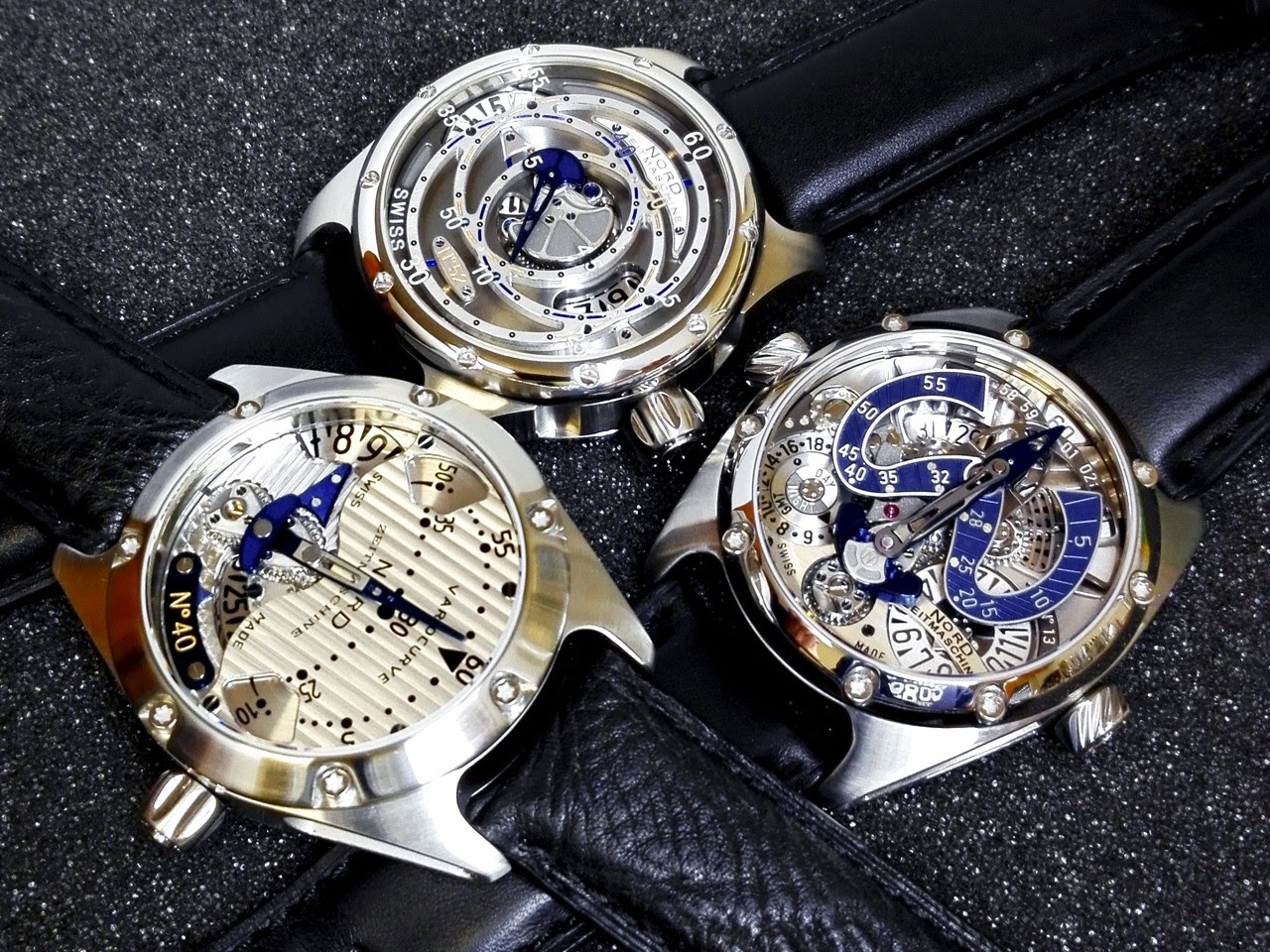
Daniel Nebel has chosen the ETA 2824 base movement because it is well proven and reliable, of excellent quality build, with easy spares availability, and a lot of torque (ETA 2892 and 2893 movements would have about 30% less torque, and this is also the handicap of the various “noble” movements available to independent manufacturers). When he mentioned to have nevertheless thought about a change to please enthusiasts directly linking the base movement with a value appraisal of the whole watch (however special it is), I could not quite understand how this could allure him from the no-compromise-attitude upheld elsewhere.
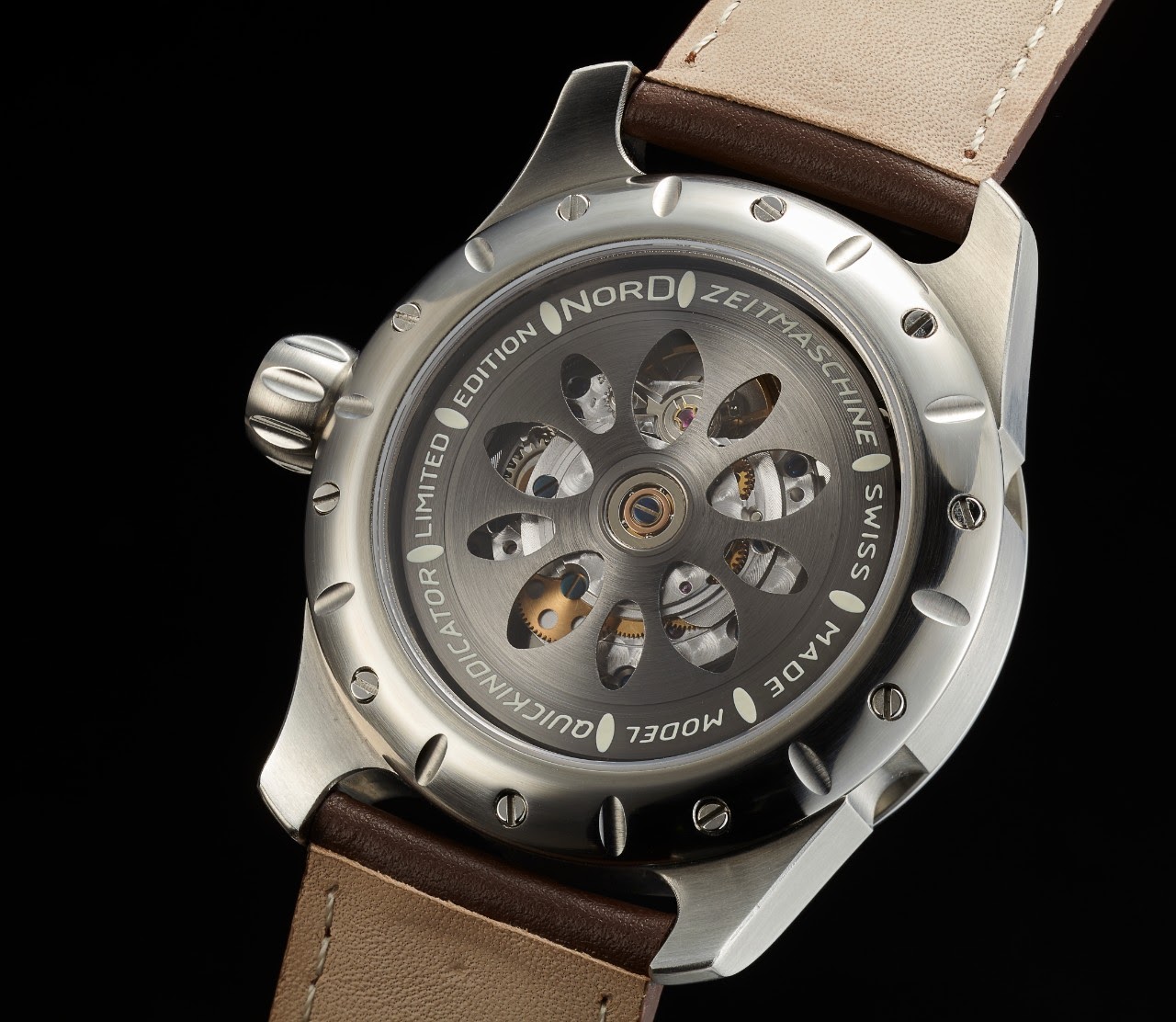
There are enough precedents that enthusiasts accept technical considerations when advocated by well-known experts of the trade. Urwerk , also in need of a strong base movement for the satellite/carousel display mechanisms, does not care about blinkered views, and Felix Baumgartner commented (Time Werke , p. 9) the use of Sowind/GP movements (and they used/use also La Joux-Perret and Zenith base movements): “We do not highlight it as we did not create it. The focus and complexities of our device is for everybody to see on the dial and the case back. […] Our creation is about artistic reflections rather than traditional values found in watchmaking.” And ochs und junior states on its website: “Ludwig Oechslin has based most of his modular innovations around movements supplied by ETA in Biel/Bienne. He implicitly trusts the longevity of ETA movements, which is why he specifies them for most of our watches.” So why should Daniel Nebel bother when his offer is only meant for a small circle of likely knowledgeable enthusiasts anyway? In the car world the engines of Ford respectively Chevrolet hindered also not an appreciation for Shelby Cobras and Bizzarrinis because the fans focus on the other qualities of these cars, and the engines were definitely no disadvantage in racing.
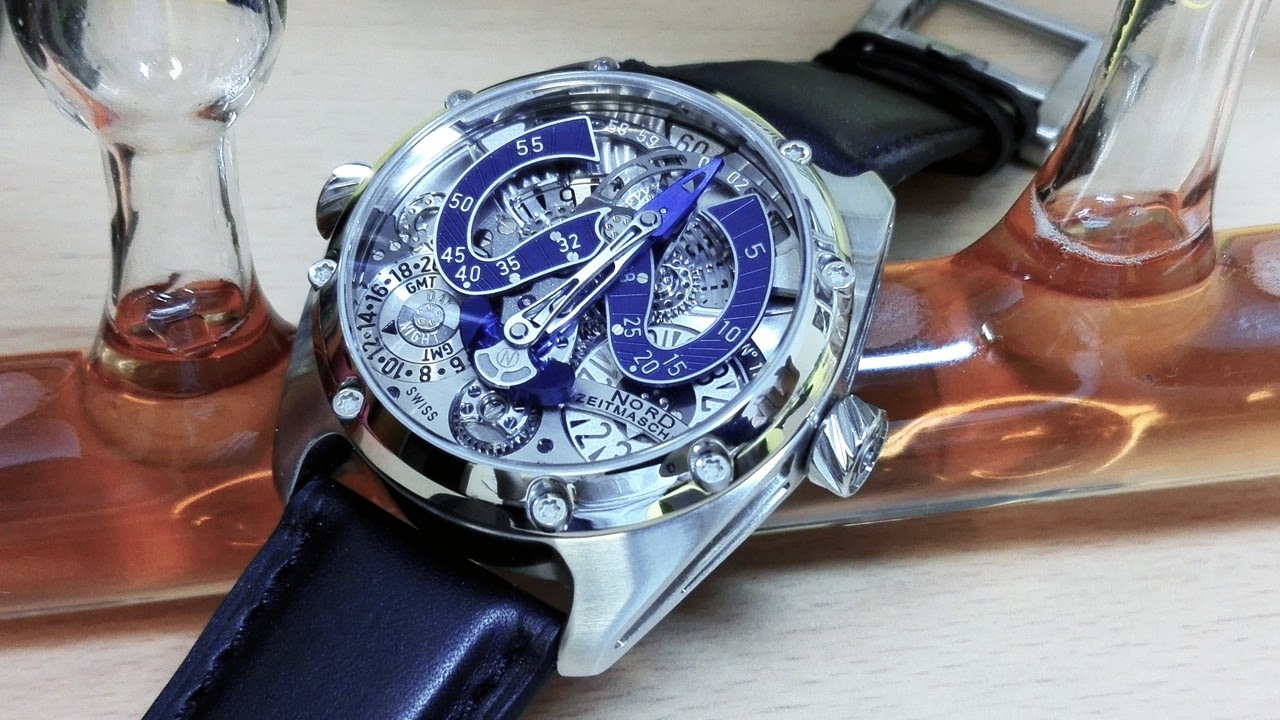
The tiny niche found by Nord Zeitmaschine will not be abandoned. Daniel Nebel is fond of this play of superbly engineered small parts which can still properly fulfil a function as a watch, while as an experienced engineer he should put the mantra “Keep it simple, stupid” on his flag. The fact that he does not do it, confirms that in his heart it IS the kinetic art he wants to showcase. He is always full of ideas how further elements could be added to enhance the unusual movement of parts, so I am sure future models will extend the line started with the Variocurve in 2011.
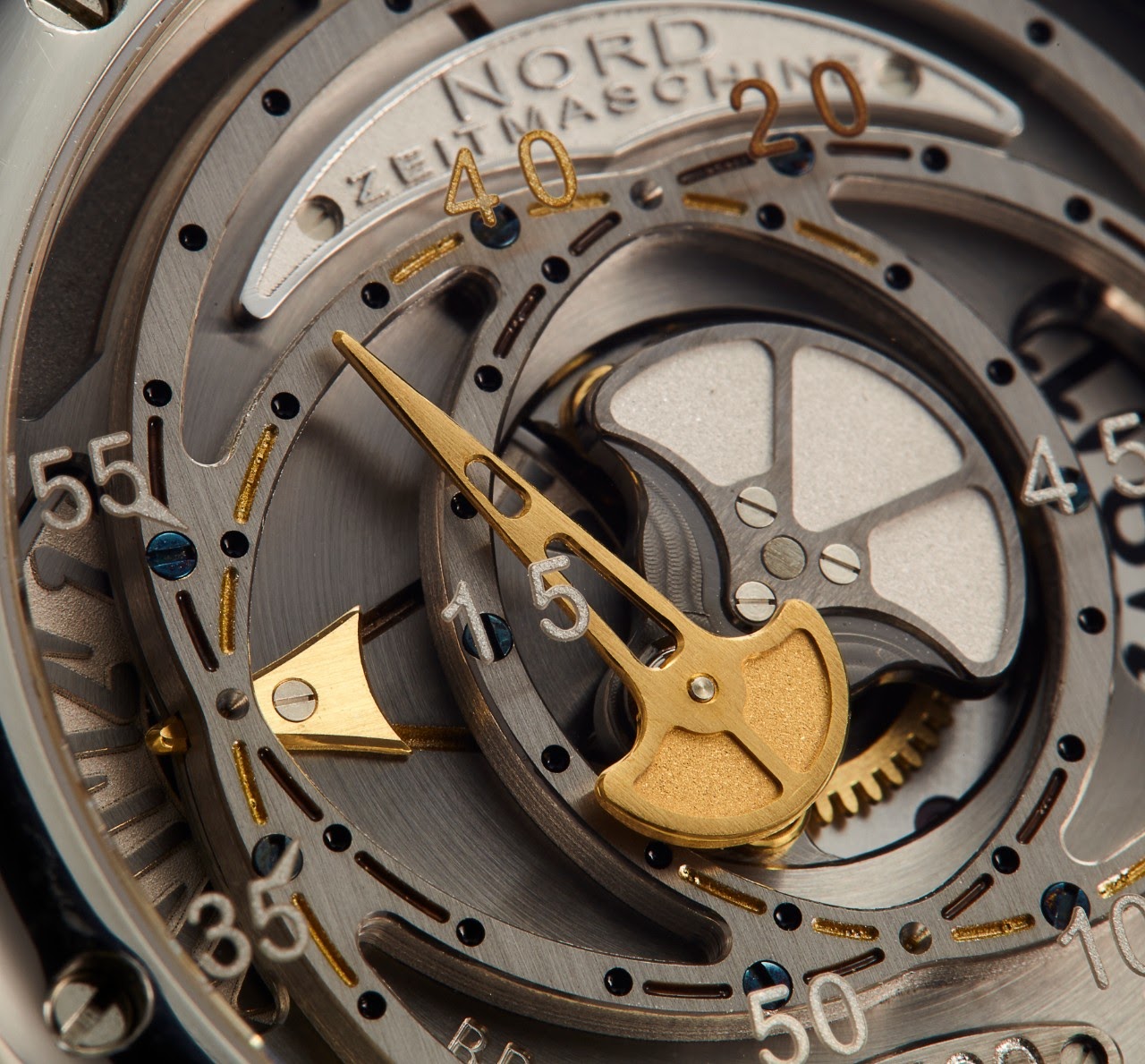
There is a very short wish list, with a laser engraving machine on it. The chosen processes (milling all the parts from solid blocks of metal) limit an individualisation to colouring by galvanic treatments at the moment. For simple hand engraving a manual pantograph engraver is available. Reprogramming the milling for different decorations would, on the other hand, just be unviable due to the time required for it. Laser engravings would open up possibilities for a more extensive personalization of the watches.
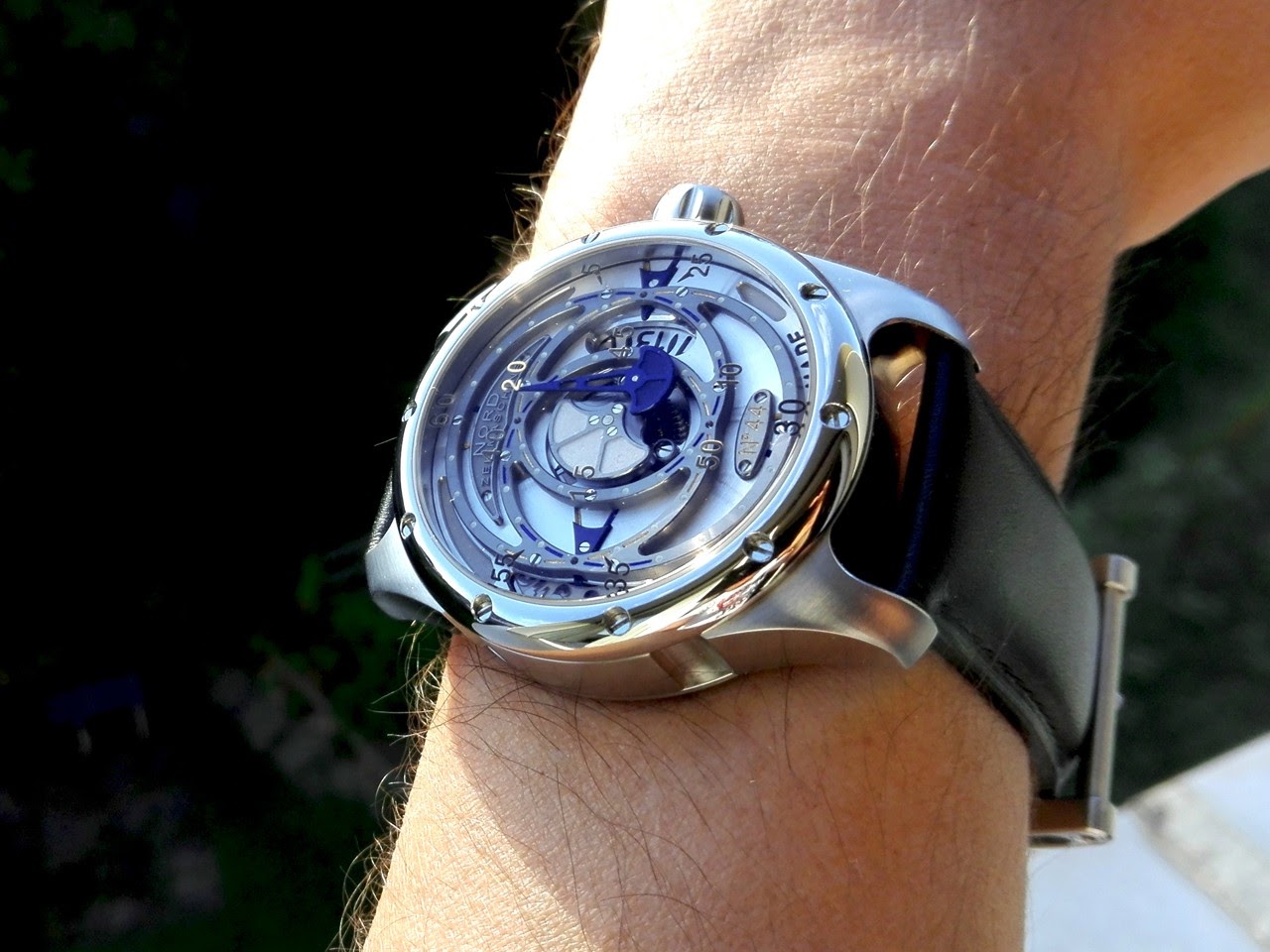
Conclusion
For me, the Nord Zeitmaschine models are part of the group of those watches I needed to have in my hands or on my wrist to really recognise the superb engineering in them. Just casually looking at any of them, I saw for a long time only the funny time display, but not what mechanical treasures are to be found behind this. Daniel Nebel is also far too modest about what he achieves to create literally from bars of raw materials. He accepts only the highest standards for himself and takes the results in his watches for granted. You definitely get no BS from him. For a technical layman (like me) it would nevertheless now and then help to have the attention drawn to the skills employed and necessary, to be able to properly appreciate such unusual creations, beginning with the dancing stars of the show, the minute hands.
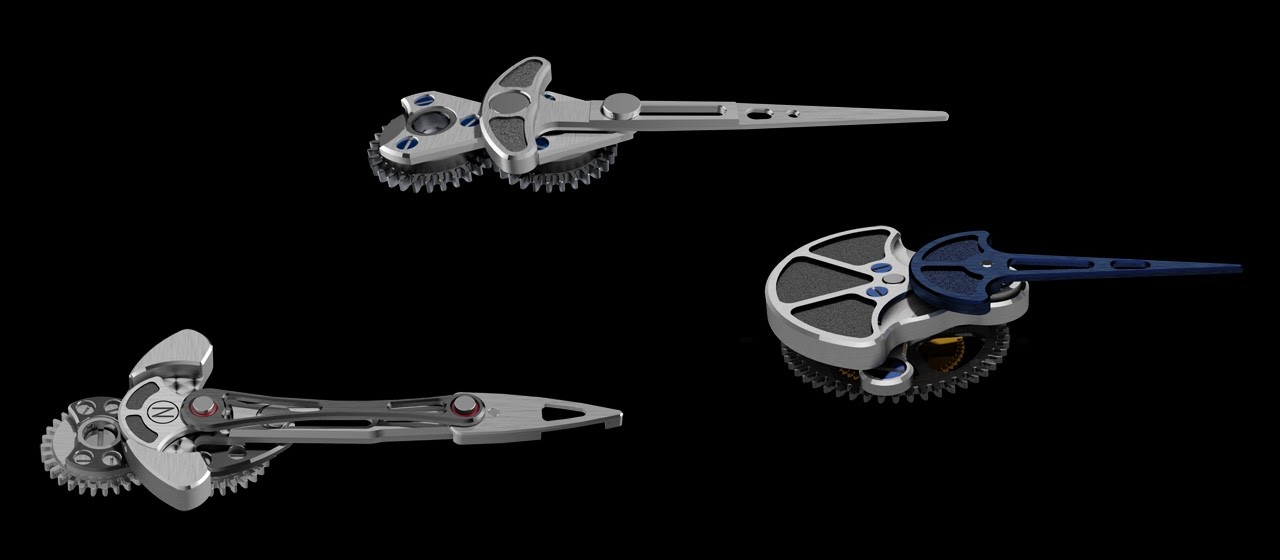
Tinguely published in 1959 a manifesto. Extracted, he stated: “Everything moves continuously. Immobility does not exist. Don’t be subject to the influence of out-of-date concepts. Forget hours, seconds and minutes. Accept instability. Live in Time. […] Resist the anxious wish to fix the instantaneous, to kill that which is living. Stop insisting on ‘values’ which can only break down. Be free, live.”
I believe that Daniel Nebel does not only share Tinguely’s love for playful mechanical sculptures, but also lives life as Tinguely proclaimed. In contrast to many parts of the main watch industry, he just does not care what others think about his creations. He designs and builds in total independence what he enjoys and what fulfils his high engineering standards. He hopes to find year by year enough enthusiasts who appreciate what he likes. In addition, his lifestyle does not put undue financial pressure on him. And with his skills he could likely go back anytime into the industry where he started off. While a business economist would be horrified that the created added value is not better retained, it is a superb basis for watch enthusiasts to get quality without any corners cut for commercial reasons. Furthermore, this attitude leads to totally authentic creations. And authenticity is for me one of the most valuable assets I am looking for in quality watches.

Nord Zeitmaschine reminds that treasures and surprises can still be found in the watch industry amongst the re-editions of 60s-style watches and other repetitions of the known by many of the big brands. Sometimes you have just to nudge yourself and risk a view beyond your garden wall, whatever the main interests or collecting themes are.
On this forum there are already other fans of Daniel Nebel’s watches, e.g., Jocke who offers a review with beautiful photos of his Variocurve :
Björn
(Photos: Daniel Nebel, Timm Delfs, Walter A. Bechtler-Stiftung, Miki Eleta, Colonial Arts, Jürg Meier)








Next Article
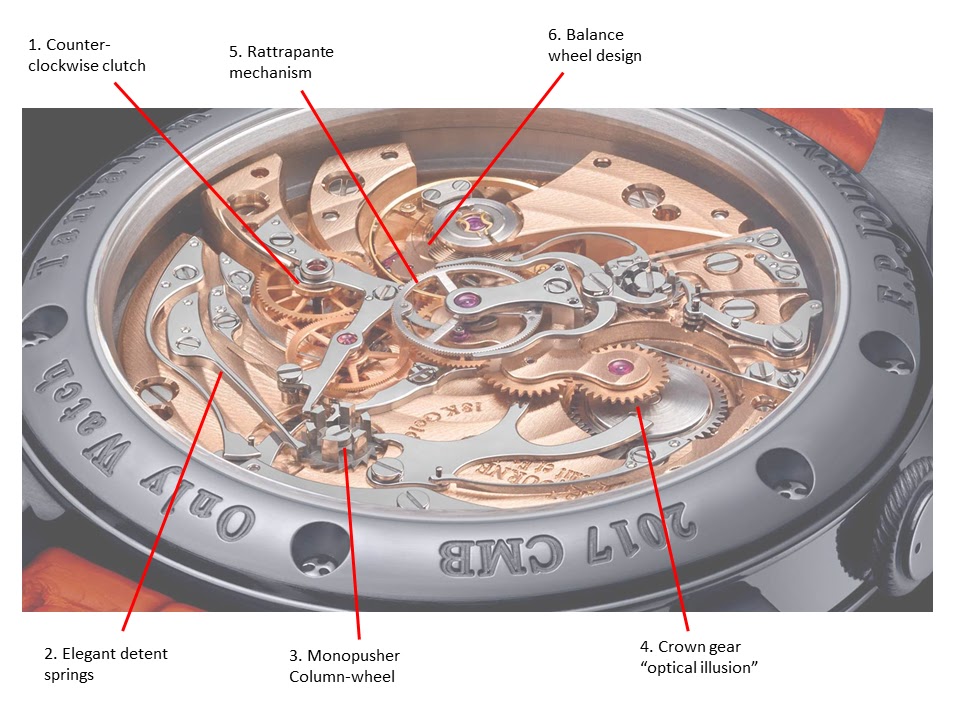

F.P. Journe Monopusher Split Seconds Chronograph – a Movement Analysis

© 2017 - WatchProZine